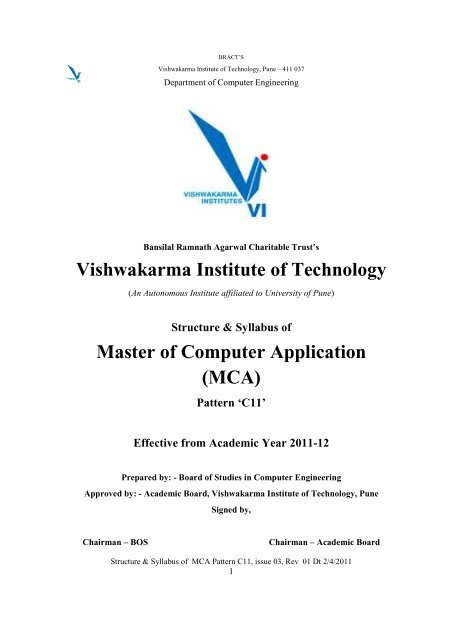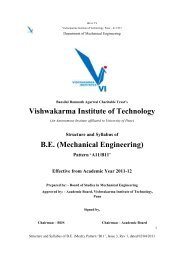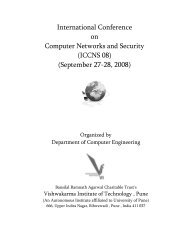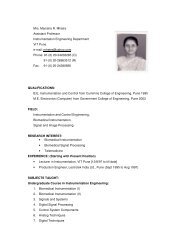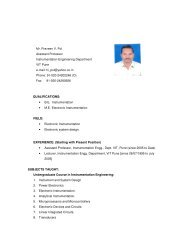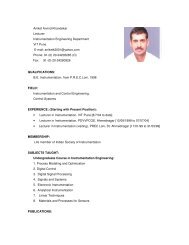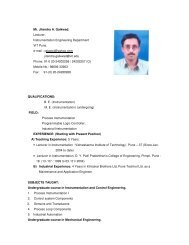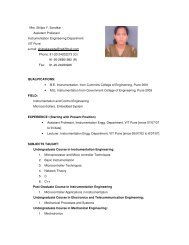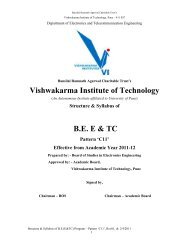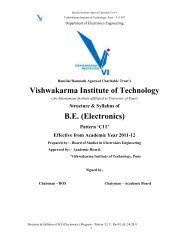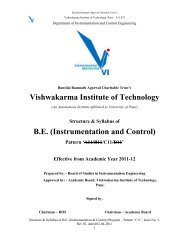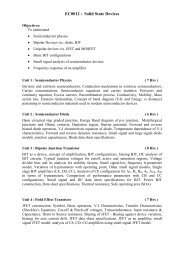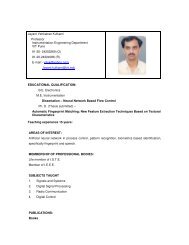Vishwakarma Institute of Technology Master of Computer ...
Vishwakarma Institute of Technology Master of Computer ...
Vishwakarma Institute of Technology Master of Computer ...
Create successful ePaper yourself
Turn your PDF publications into a flip-book with our unique Google optimized e-Paper software.
BRACT’S<br />
<strong>Vishwakarma</strong> <strong>Institute</strong> <strong>of</strong> <strong>Technology</strong>, Pune – 411 037<br />
Department <strong>of</strong> <strong>Computer</strong> Engineering<br />
Bansilal Ramnath Agarwal Charitable Trust’s<br />
<strong>Vishwakarma</strong> <strong>Institute</strong> <strong>of</strong> <strong>Technology</strong><br />
(An Autonomous <strong>Institute</strong> affiliated to University <strong>of</strong> Pune)<br />
Structure & Syllabus <strong>of</strong><br />
<strong>Master</strong> <strong>of</strong> <strong>Computer</strong> Application<br />
(MCA)<br />
Pattern ‘C11’<br />
Effective from Academic Year 2011-12<br />
Prepared by: - Board <strong>of</strong> Studies in <strong>Computer</strong> Engineering<br />
Approved by: - Academic Board, <strong>Vishwakarma</strong> <strong>Institute</strong> <strong>of</strong> <strong>Technology</strong>, Pune<br />
Signed by,<br />
Chairman – BOS Chairman – Academic Board<br />
Structure & Syllabus <strong>of</strong> MCA Pattern C11, issue 03, Rev 01 Dt 2/4/2011<br />
1
BRACT’S<br />
<strong>Vishwakarma</strong> <strong>Institute</strong> <strong>of</strong> <strong>Technology</strong>, Pune – 411 037<br />
Department <strong>of</strong> <strong>Computer</strong> Engineering<br />
Content<br />
Sr. No. Title Page No<br />
1 Course Structure – Semester V 4<br />
2 Course Syllabi for - Semester V 5<br />
2.1 CS70104 Object Oriented Modeling & Design(Theory) 5<br />
2.2 CS70105 S<strong>of</strong>tware Testing & Quality Assurance(Theory) 8<br />
2.3 CS70106 course) Application DevelopmentTechnologies(Theory) 11<br />
2.4 Elective )course) II<br />
CS72307 • Advanced Internet Technologies 14<br />
CS72308 • Advanced Unix Programming 17<br />
CS72309 • Multimedia 19<br />
CS72310 • Data Warehousing and Data Mining 22<br />
CS72311 • Artificial Intelligence 24<br />
2.5 Elective III<br />
2.6 CS72105 • Organizational Behavior (OB) 27<br />
2.7 CS72104 • S<strong>of</strong>tware Project Management (SPM) 29<br />
2.8 CS72106 • Enterprise Resource 32<br />
2.9 CS72112 • Geographical Information Systems (GIS) 34<br />
2.10 CS70302 S<strong>of</strong>tware Design & Testing Lab 37<br />
2.11 CS70306 Application Devlopment <strong>Technology</strong> Lab 40<br />
Elective II Laboratory<br />
CS72307 • Advanced Internet Technologies Lab 42<br />
CS72308 • Advanced Unix Programming Lab 44<br />
CS72309 • Multimedia Lab 46<br />
CS72310 • Data Warehousing and Data Mining Lab 48<br />
CS72311 • Artificial Intelligence Lab 50<br />
3 Course Structure – Semester VI 52<br />
4 Course Syllabi for - Semester VI 53<br />
4.1 CS77402 Project 53<br />
4.2 CS77403 Seminar 56<br />
Structure & Syllabus <strong>of</strong> MCA Pattern C11, issue 03, Rev 01 Dt 2/4/2011<br />
2
BRACT’S<br />
<strong>Vishwakarma</strong> <strong>Institute</strong> <strong>of</strong> <strong>Technology</strong>, Pune – 411 037<br />
Department <strong>of</strong> <strong>Computer</strong> Engineering<br />
SEMESTER V<br />
Structure & Syllabus <strong>of</strong> MCA Pattern C11, issue 03, Rev 01 Dt 2/4/2011<br />
3
BRACT’S<br />
<strong>Vishwakarma</strong> <strong>Institute</strong> <strong>of</strong> <strong>Technology</strong>, Pune – 411 037<br />
Department <strong>of</strong> <strong>Computer</strong> Engineering<br />
MCA-SEM V STRUCTURE<br />
FF653, Issue No. 3, Rev 1, dt 02/04/2011<br />
Subject No. Subject Code Subject Name Teaching Scheme (Hrs/week) Credits<br />
Lect. Tutorial Practical<br />
S1 CS70104 Object Oriented Modeling & Design 3 0 0 3<br />
S2 CS70105 S<strong>of</strong>tware Testing & Quality Assurance 3 0 0 3<br />
S3 CS70106 Application DevelopmentTechnologies 3 0 0 3<br />
S4 Elective II 3 0 0 3<br />
S5 Elective III 3 0 0 3<br />
P1 CS70302 Design and Testing Lab 0 0 4 2<br />
P2 CS70306 Advanced DevelopmentTechnologies Lab 0 0 2 1<br />
P3 Elective II Lab 0 0 2 1<br />
Total 15 0 10 19<br />
Structure & Syllabus <strong>of</strong> MCA Pattern C11, issue 03, Rev 01 Dt 2/4/2011<br />
4
BRACT’S<br />
<strong>Vishwakarma</strong> <strong>Institute</strong> <strong>of</strong> <strong>Technology</strong>, Pune – 411 037<br />
Department <strong>of</strong> <strong>Computer</strong> Engineering<br />
CS70104: Object Oriented Modeling and Design<br />
Structure & Syllabus <strong>of</strong> MCA Pattern C11, issue 03, Rev 01 Dt 2/4/2011<br />
5<br />
FF No. : 654<br />
Credits: 03 Teaching Scheme: - Theory 3 Hrs/Week<br />
Prerequisites:<br />
1. S<strong>of</strong>tware Engineering<br />
2. Object Oriented Programming<br />
Objectives:<br />
• To experience the insights necessary to obtain maximum benefit from object<br />
technology<br />
• To understand the need for, the place <strong>of</strong>, and aims <strong>of</strong>, requirements, analysis and<br />
design<br />
• To thoroughly understand the practices <strong>of</strong> analysis and design (OOA and OOD)<br />
• To understand the practical connections between the theory <strong>of</strong> object-oriented design<br />
and the object-oriented programming languages<br />
• To become familiar with the unified modelling language (UML 1.x or UML 2.0)<br />
• To understand the relative merits <strong>of</strong> the different UML diagrams, distinguishing those<br />
diagrams most likely always to be useful to typical projects from those diagrams<br />
more likely to be <strong>of</strong> interest to more specialized projects<br />
• Transforming analysis behavioral models into design sequence diagrams .<br />
Unit I (9+2Hrs)<br />
Introduction to Object Orientation<br />
A Elements <strong>of</strong> UML: The importance <strong>of</strong> modeling, enabling concise communication,<br />
Building blocks: things, relationships and diagrams, Architectural views: use case, design,<br />
implementation, process and deployment, Object-oriented Methodology: Object<br />
properties: Abstraction, encapsulation, Modularity, Hierarchy, Overview <strong>of</strong> OO<br />
Methodologies: Object-Oriented Analysis and Design, Object Oriented S<strong>of</strong>tware<br />
Engineering, Object Modelling Technique<br />
B. Levels <strong>of</strong> detail: visualization, specification and construction , Dynamic Systems<br />
Development Method, Responsibility-driven design, Enterprise Unified Process
BRACT’S<br />
<strong>Vishwakarma</strong> <strong>Institute</strong> <strong>of</strong> <strong>Technology</strong>, Pune – 411 037<br />
Department <strong>of</strong> <strong>Computer</strong> Engineering<br />
Unit II (9+2Hrs)<br />
UML 2.0, Interfaces and Application <strong>of</strong> UML<br />
A. Programming In Small Versus Programming In Large, Overview <strong>of</strong> Model Driven<br />
Development, Introduction to Model Driven Architecture: MDA Terms and Concepts,<br />
Model Mappings, Marking Models, Executable Models, MOF and XMI, Introduction to<br />
UML Metamodel, Extensibility Mechanisms and its usage, Introduction to OCL , UML<br />
2.0 Diagram set , Packages and interfaces: Distinguishing between classes/interfaces,<br />
Component and deployment diagrams: Describing dependencies, Deploying components<br />
across threads, processes and processors<br />
B. Exposing class and package interfaces, Subscribing to interfaces , UML 2.0 in<br />
Application Engineering: Application <strong>of</strong> UML in Embedded System, Application <strong>of</strong><br />
UML in Web Engineering, Forward Engineering and Reverse Engineering Concepts,<br />
Comparison <strong>of</strong> Feature sets <strong>of</strong> UML 1.4 and 2.0 versions<br />
Unit III (9+2 Hrs)<br />
The Behavioral Model<br />
A. Use Cases: Use Cases, Use Case Diagram Components, Use Case Diagram, Actor<br />
Generalization, Include and Extend, Template for Use Case Narrative, Using Use Cases<br />
Domain Analysis: Top View - The Domain Perspective, Data Dictionary: Finding the<br />
Objects, Responsibilities, Collaborators, and Attributes, CRC Cards, Producing<br />
Requirements Models, Capturing system behavior in use cases: Finding primary and<br />
secondary use cases , Include and Extend dependencies, Use case generalization<br />
relationships, Refining use cases: rapid prototypes<br />
B. Class Models and Use Case Models, Judging the Domain Model, Creating the domain<br />
object model: Building a class description database, Finding analysis classes, Managing<br />
Unit IV (9+2 Hrs)<br />
Object Analysis<br />
A. Use case realization: Sequence diagrams, object lifelines and message types, Modeling<br />
collections multiobjects, Refining sequence diagrams, Tying object and behavioral<br />
models with collaboration diagrams, Implementing memory in objects using state<br />
machines: States, events and actions Nested machines and concurrency, Converting<br />
sequence diagrams into communicating state machines, Modifying the object model to<br />
facilitate states<br />
B. Analyzing object behavior: Modeling methods with activity diagrams, Activity<br />
Diagrams: Decisions and Merges, Synchronization, Drilling Down, Iteration, Partitions,<br />
Parameters and Pins, Expansion Regions, Swimlanes, concurrency and synchronization<br />
Other Behavioral Diagrams: Communication Diagram, Interaction Overview Diagrams<br />
Timing Diagrams<br />
Structure & Syllabus <strong>of</strong> MCA Pattern C11, issue 03, Rev 01 Dt 2/4/2011<br />
6
BRACT’S<br />
<strong>Vishwakarma</strong> <strong>Institute</strong> <strong>of</strong> <strong>Technology</strong>, Pune – 411 037<br />
Department <strong>of</strong> <strong>Computer</strong> Engineering<br />
Unit V (9+2 Hrs)<br />
Object Design<br />
A. Design <strong>of</strong> Objects: Design and Factoring, Design <strong>of</strong> S<strong>of</strong>tware Objects, Features and<br />
Methods, Cohesion <strong>of</strong> Objects, Coupling between Objects Coupling and Visibility,<br />
Inheritance, Advanced Objects: Constructors & Destructors, Instance Creation, Abstract<br />
Classes , Polymorphism, Multiple Inheritance and associated Problems, Interfaces,<br />
Interfaces with Ball and Socket Notation, Templates , Establishing The Object Model:<br />
Refining classes and associations, Analysis model vs. design model classes, Categorizing<br />
classes: entity, boundary and control<br />
B. Modeling associations and collections, Preserving referential integrity , Achieving<br />
reusability, Isolating reusable base classes, Reuse through delegation, Identifying and<br />
using service packages, Improving reuse with design patterns<br />
Text Books<br />
1. Jim Arlow, Ila Neustadt, “UML 2 and Unified Process: Practical Object Oriented<br />
Analysis and Design. ”, 2 nd Edition, Addison- Wesley, ISBN – 0321321278.<br />
2. Tom Pender, “UML Bible”, John Wiley & sons, ISBN – 0764526049..<br />
Reference Books<br />
1. Grady Booch, James Rambaugh, Ivar Jacobson, “Unified Modeling Language Users<br />
Guide”, 2 nd Edition, Addison- Wesley, ISBN – 0321267974.<br />
2. Martin Flower, “UML Distilled: A Brief Guide to The Standard Object Modeling<br />
Language ”, 3 rd Edition, Addison- Wesley, ISBN – 0321193687.<br />
Additional Reading<br />
1. Mellor, Scott, Uhl, Weise, “MDA Distilled”, Pearson Education, ISBN 81-297-0529X<br />
Structure & Syllabus <strong>of</strong> MCA Pattern C11, issue 03, Rev 01 Dt 2/4/2011<br />
7
BRACT’S<br />
<strong>Vishwakarma</strong> <strong>Institute</strong> <strong>of</strong> <strong>Technology</strong>, Pune – 411 037<br />
Department <strong>of</strong> <strong>Computer</strong> Engineering<br />
Structure & Syllabus <strong>of</strong> MCA Pattern C11, issue 03, Rev 01 Dt 2/4/2011<br />
8<br />
FF No. : 654<br />
CS70105:: SOFTWARE TESTING & QUALITY ASSURANCE<br />
Credits: 03 Teaching Scheme: - Theory 3 Hrs/Week<br />
Prerequisites: S<strong>of</strong>tware Engineering<br />
Objectives:<br />
• To understand S<strong>of</strong>tware Measurement Theory and S<strong>of</strong>tware Test Automation<br />
• To practice S<strong>of</strong>tware Testing Techniques and Strategies<br />
• Understand the fundamental concepts, approaches, and methodologies in s<strong>of</strong>tware<br />
quality management and assurance.<br />
• Understand the framework and general approach <strong>of</strong> several Quality System Standards<br />
and Total Quality Management (TQM).<br />
Unit I (9+2 Hrs)<br />
S<strong>of</strong>tware Measurement<br />
A. Measurement Theory and Why to Measure the S<strong>of</strong>tware, Measurement and Models,<br />
Measurement Scales, Classification <strong>of</strong> S<strong>of</strong>tware Measures, Measurement Framework,<br />
Aspects <strong>of</strong> S<strong>of</strong>tware Size, S<strong>of</strong>tware Length and Reuse, S<strong>of</strong>tware Functionality and<br />
Complexity, Types <strong>of</strong> Structural Measures, Control Flow Structures, Halstead’s S<strong>of</strong>tware<br />
Science, Product Quality Metrics, In-Process Quality Metrics, The Rayleigh Model,<br />
Exponential Distribution and Reliability Growth Models<br />
B. SRE process, Reliability Concepts: Hardware and S<strong>of</strong>tware, Deploying SRE<br />
Unit II<br />
Principles <strong>of</strong> Testing<br />
(9+2 Hrs)<br />
A. Testing Concepts: Purpose <strong>of</strong> S<strong>of</strong>tware Testing, Testing Principles, Goals <strong>of</strong> Testing,<br />
Testing aspects: Requirements, Test Scenarios, Test cases, Test scripts/procedures,<br />
Strategies for S<strong>of</strong>tware Testing, Testing Activities, Mistakes, Faults & Failures, Planning<br />
Verification and Validation, S<strong>of</strong>tware Inspections, Automated Static Analysis,<br />
Verification and Formal Methods, Levels <strong>of</strong> Testing, White-Box Testing: Test Adequacy<br />
Criteria, Static Testing, Structural Testing, Code Complexity Testing, Mutation Testing,<br />
Data Flow Testing, Black-Box Testing: Test Case Design Criteria, Requirement Based<br />
Testing, Positive and Negative Testing, Boundary Value Analysis, Equivalence<br />
Partitioning State Based Testing, Domain Testing<br />
B. Analysis <strong>of</strong> Flow Graphs, Complexity Measures and computations
BRACT’S<br />
<strong>Vishwakarma</strong> <strong>Institute</strong> <strong>of</strong> <strong>Technology</strong>, Pune – 411 037<br />
Department <strong>of</strong> <strong>Computer</strong> Engineering<br />
Unit III (8+1 Hrs)<br />
Functional Testing<br />
A. Test Plan, Test Management, Test Execution and Reporting, Test Specialist Skills,<br />
Tester’s Workbench and Tool Categories, Test Maturity Model and Test Process<br />
Assessment, Debugging & Root Cause Analysis, S<strong>of</strong>tware Items, Component & Units,<br />
Test Bed, Traceability and Testability, Attributes <strong>of</strong> Testable Requirements, Test Matrix,<br />
Benefits <strong>of</strong> Formal Test Documentation, Types <strong>of</strong> Testing Documentation, Verification<br />
Testing, Validation Testing, Integration Testing, System and Acceptance Testing, GUI<br />
Testing, , Regression Testing<br />
B. S<strong>of</strong>tware Defects: Origins <strong>of</strong> Defects, Defect Classes, Defect Repository / Test<br />
Design, Developer/Tester Support for Defect Repository, Need for Testing<br />
Unit IV (9+2 Hrs)<br />
Higher Order Testing<br />
A. Specification Based Testing, Performance Testing, Ad-hoc Testing, Usability and<br />
Accessibility Testing, Risk-based Testing, Exploratory Testing, Scenario-based Testing,<br />
Random Testing Compatibility Testing, User Documentation Testing, Client –Server<br />
System Testing, RAD Testing, Configuration Testing, Testing internal Controls,<br />
Multiplatform Environment Testing, Security Testing, Web-based System Testing,<br />
Testing VS Test Automation, Tool evaluation and selection, Automation team roles,<br />
Architectures, Planning and implementing test automation process<br />
B. IEEE Standards Related to Testing, ISO 12207 & IEEE/EIA Std12207on Testing, ISO<br />
9000:2000 on Testing, ISO 9003, IEEE Std 1012, IEEE Std 1028<br />
Unit V (9+2 Hrs)<br />
S<strong>of</strong>tware Quality Assurance<br />
A. Quality Concepts, S<strong>of</strong>tware Quality Assurance, Planning for SQA, Six Sigma<br />
Principles, Malcolm Baldridge Assessment, Edward Deming’s Principles, Total Quality<br />
Management, Product Quality Metrics, In-Process Quality Metrics, Ishikawa’s Seven<br />
Basic Tools, Using Agile Methods to Improve S<strong>of</strong>tware Testing, Building Agility into the<br />
Testing Process, S<strong>of</strong>tware Maintenance, Purpose <strong>of</strong> Inspection, Cost <strong>of</strong> Inspections,<br />
Defect Detection and Prevention, Feedback, Feed-forwards and Control, Flow <strong>of</strong><br />
Inspection Process, Activities <strong>of</strong> Inspection, Economics <strong>of</strong> Inspections<br />
B. S<strong>of</strong>tware Benchmarks and Baselines, Key Factors for S<strong>of</strong>tware Assessment and<br />
Benchmark Studies, Identifying S<strong>of</strong>tware Best and Worst Practices<br />
Text Books<br />
1. Fenton, Pfleeger, “S<strong>of</strong>tware Metrics: A Rigourous and practical Approach”,<br />
Thomson Brooks/Cole, ISBN 981-240-385-X.<br />
2. Desikan, Ramesh, “ S<strong>of</strong>tware Testing: principles and Practices”, Pearson<br />
Education, ISBN 81-7758-121-X.<br />
Structure & Syllabus <strong>of</strong> MCA Pattern C11, issue 03, Rev 01 Dt 2/4/2011<br />
9
Reference Books<br />
BRACT’S<br />
<strong>Vishwakarma</strong> <strong>Institute</strong> <strong>of</strong> <strong>Technology</strong>, Pune – 411 037<br />
Department <strong>of</strong> <strong>Computer</strong> Engineering<br />
1. Burnstein, “Practical S<strong>of</strong>tware Testing”, Springer International Edition, ISBN<br />
81-8128-089-X<br />
2. William E. Perry, “ Effective Methods for S<strong>of</strong>tware Testing”, John Wiley and<br />
Sons, ISBN 9971-51-345-5<br />
Additional Reading<br />
1. Nina Godbole, “S<strong>of</strong>tware Quality Assurance: Principles And Practice”,Alpha<br />
Science International, Ltd (August 1, 2004) ISBN-10: 1842651765 ISBN-13: 978-<br />
1842651766<br />
2. Ronald Radice, “S<strong>of</strong>tware Inspections”, Tata McGraw Hill, ISBN 0-07-048340-X<br />
3. Capers Jones,” S<strong>of</strong>tware Assessments, Benchmarks, and Best Practices” ,Burlington,<br />
Vermont Publisher: Addison-Wesley Pr<strong>of</strong>essional 2000 ISBN-10: 0201485427<br />
,ISBN-13: 9780201485424<br />
Structure & Syllabus <strong>of</strong> MCA Pattern C11, issue 03, Rev 01 Dt 2/4/2011<br />
10
BRACT’S<br />
<strong>Vishwakarma</strong> <strong>Institute</strong> <strong>of</strong> <strong>Technology</strong>, Pune – 411 037<br />
Department <strong>of</strong> <strong>Computer</strong> Engineering<br />
Structure & Syllabus <strong>of</strong> MCA Pattern C11, issue 03, Rev 01 Dt 2/4/2011<br />
11<br />
FF No. : 654<br />
CS70103:: APPLICATION DEVELOPMENT TECHNOLOGY<br />
Credits: 03 Teaching Scheme: - Theory 3 Hrs/Week<br />
Prerequisites: Object Oriented Concepts, Web Programming basics<br />
Objectives:<br />
• To learn application development tool with .NET framework.<br />
• To provide the knowledge and skills required to describe the basic features <strong>of</strong> the<br />
Micros<strong>of</strong>t .NET technologies through a high level overview <strong>of</strong> the terminology and<br />
key concepts, architecture, programming.<br />
Unit I (9+2 Hrs)<br />
Overview <strong>of</strong> .NET<br />
A. NET as better Programming Platform,�.NET Framework, Understanding the<br />
framework class library, Understanding common language runtime,.NET Architecture,<br />
The Just-In-Time Compiler ,MSIL, NET Framework class library , introduction Creating<br />
Applications ,Building Projects Using simple components, Running VB.NET<br />
Applications. Windows Forms. Controls :�Text Boxes, Buttons, Labels, Check Boxes, and<br />
Radio Buttons. List Boxes, Combo Boxes. Picture Boxes, Scrollbars, Splitters, Timer<br />
,�Menus , Built-in Dialogs� Image List, Tree Views, List Views, Toolbars, Status Bar and<br />
Progress bars.<br />
B. Windows application with use <strong>of</strong> controls.<br />
Unit II (9+2 Hrs)<br />
Object Oriented Programming<br />
A. Class and Object, �Properties, methods and events, �Constructors and Destructors<br />
,�Method overloading ,�Inheritance, �Access modifiers : Public, Private, Protected, Friend.<br />
Overloading and Overriding .�Interfaces .�Polymorphism. File handling :�File handling<br />
using FileStream , StreamWriter , StreamReader, BinaryReader, BinaryWriter<br />
classes.,�File and Directory Classes. Themes: Need for themes, creating themes, adding<br />
skins to themes, Themes versus StyleSheetThemes, Configuring themes, Adding CSS to<br />
themes, creating global themes, applying themes dynamically, cookies, session<br />
management<br />
B. Displaying properties and methods using a <strong>Master</strong> page, applying themes at control<br />
and runtime levels, Navigation controls
BRACT’S<br />
<strong>Vishwakarma</strong> <strong>Institute</strong> <strong>of</strong> <strong>Technology</strong>, Pune – 411 037<br />
Department <strong>of</strong> <strong>Computer</strong> Engineering<br />
Unit III<br />
(9+2 Hrs)<br />
ADO.NET and Data Access Controls<br />
A. Connected data access: Connection object, Command object, DataReader object,<br />
Disconnected data access: DataAdapter object, DataTable object, DataView object,<br />
DataSet object, creating stored procedures with .NET Framework, Data Access Controls:<br />
GridView, DataList, Details View, Form View, List View, Repeater, sqlDataSource<br />
control<br />
B. Architecture <strong>of</strong> ADO.NET data services, Features <strong>of</strong> ADO.NET data services<br />
Unit IV (9+2 Hrs)<br />
Web Applications (ASP .NET)<br />
A. Creating web applications ,Event handling ,Data preservation in Client and Server<br />
Multiform web application ,Embedding VB Code in web pages , web controls, html<br />
controls , Validation controls: validation controls and javascript, page.IsValid property,<br />
RequiredfieldValidator control, RangeValidator control, CompareValidator control,<br />
ValidationSummery control, Rich controls: File uploads, Date picker, Calendar control<br />
Cookies. data controls in web applications<br />
B. Link button, Image button, CheckBoxList control, multiview control,<br />
RegularExpressionValidator control, CustomValidator control<br />
Unit V (9+2 Hrs)<br />
ASP.NET Web Services and AJAX<br />
A. Web Services Directory, Web Services Discovery, Web Services Description, Web<br />
Services Description Language, Configuring authentication, Configuring authorization,<br />
ASP.NET membership, introduction to AJAX.<br />
B. Web service application property, Web service context property, Handling update<br />
panel errors<br />
Text Books<br />
1. Steven Holzner, Dreamtech Press , “Visual Basic .Net Black Book” ,2006<br />
2. “Asp.Net Black Book”, Dreamtech Press,2006<br />
Reference Books<br />
1. "The Complete Reference Asp.Net", Metthew Macdonald, Tata Mcgraw-Hill<br />
Publications, Isbn-13: 978-0-07-049536-4<br />
2. "Asp.Net 1.1", Chris Ullman, John Kauffman, Dreamtech Press, Isbn: 81-265-0504-4<br />
Structure & Syllabus <strong>of</strong> MCA Pattern C11, issue 03, Rev 01 Dt 2/4/2011<br />
12
BRACT’S<br />
<strong>Vishwakarma</strong> <strong>Institute</strong> <strong>of</strong> <strong>Technology</strong>, Pune – 411 037<br />
Department <strong>of</strong> <strong>Computer</strong> Engineering<br />
Additional Reading<br />
1. "ASP.NET 4 Unleashed", Stephen Walther, Kevin H<strong>of</strong>fman, Nate Dudek,<br />
Pearson Publications, ISBN: 978-81-317-5841-0<br />
Structure & Syllabus <strong>of</strong> MCA Pattern C11, issue 03, Rev 01 Dt 2/4/2011<br />
13
BRACT’S<br />
<strong>Vishwakarma</strong> <strong>Institute</strong> <strong>of</strong> <strong>Technology</strong>, Pune – 411 037<br />
Department <strong>of</strong> <strong>Computer</strong> Engineering<br />
CS72107::ADVANCE INTERNET TECHNOLOGY<br />
Structure & Syllabus <strong>of</strong> MCA Pattern C11, issue 03, Rev 01 Dt 2/4/2011<br />
14<br />
FF No. : 654<br />
Credits: 03 Teaching Scheme: - Theory 3 Hrs/Week<br />
Prerequisites: Web Programming.<br />
Objectives:<br />
• To increase the students knowledge about scripting languages.<br />
• To become familiar with PERL, CGI and PHP.<br />
• To learn and apply techniques that enhances a user’s web experience.<br />
Unit I (9+2 Hrs)<br />
PERL & CGI<br />
A. CGI Architecture , PERL features, Variables & operators, control Statements ,Working<br />
with Strings And Arrays, File Handling, Pattern matching & formatting, Creating and<br />
using subroutines, Using PERL for CGI scripting.<br />
B. Commerce as Business need, E-com Types, Advantages, Disadvantages<br />
Unit II (9+2 Hrs)<br />
ASP<br />
A. Working with simple ASP pages, Request, Response, Application, Server, Session &<br />
Cookie objects, Working with Cookies and Managing Sessions,-Role <strong>of</strong> Global.asa-ASP<br />
& databases: retrieving storing & manipulating Data, Error Handling in ASP.<br />
B. e-Commerce Architecture, Internet Payment Systems, Characteristics<br />
Unit III (9+2 Hrs)<br />
JSP<br />
A. Why JSP? JSP Directives, writing simple JSP page Scripting Elements. JSP Actions:<br />
JSP & Java Beans ,JSP Actions: include, forward and plug-in, Managing sessions using<br />
JSP, Default objects in JSP,JSP & Databases, Error Handling in JSP ,Introduction to<br />
custom tag.<br />
B. 4C Payment Methods , SET Protocol for Credit Card Payment
BRACT’S<br />
<strong>Vishwakarma</strong> <strong>Institute</strong> <strong>of</strong> <strong>Technology</strong>, Pune – 411 037<br />
Department <strong>of</strong> <strong>Computer</strong> Engineering<br />
Unit IV (9+2 Hrs)<br />
PHP Language Core<br />
A. Introduction: PHP and the Web Server Architecture Model , Overview <strong>of</strong> PHP<br />
Capabilities ,CGI vs. Shared Object Model ,PHP HTML Embedding Tags and Syntax<br />
Simple PHP Script Example ,PHP and HTTP Environment Variables, Variables,<br />
Constants and Data Types, and Operators ,Decision Making , Flow Control and Loops<br />
,Working with Arrays Strings and functions, Outputting Data, Include and Require<br />
Statements , File and Directory Access Operations , Error Handling and Reporting<br />
Considerations, Processing HTML Form Input from the User , Creating a Dynamic<br />
HTML Form with PHP ,Login and Authenticating Users , Using GET, POST, SESSION,<br />
and COOKIE variables , Session Management and Variables, Working with Cookies,<br />
Sending Email ,Introduction to Object-oriented PHP: Classes and Constructors.<br />
B. E-Cash, E- Check , Overview <strong>of</strong> Smart Card<br />
Unit V (9+2 Hrs)<br />
Database Operations with PHP<br />
A. Built-in Database Functions, Connecting to a MySQL(or Any Other Database),<br />
Selecting a Database, Building and Sending the Query to Database Engine, Retrieving ,<br />
Updating and Inserting Data<br />
Note: Apache Http Server is used at server side<br />
B. E-Commerce security, Need <strong>of</strong> security, Encryption: Public Private & Hybrid ,<br />
Digital Signature , Authentication<br />
Text Books<br />
1. “Java Servlets and JSP”, Joel Murach, Andrea Steelman, SPD Publication, 2 nd<br />
Edition, ISBN-978-1-890774-44-8<br />
2. “ASP 3.0: The Complete Reference”, Mary, Bill Slater, Divine Favors Publications;<br />
1st edition, ISBN- 978-0072125764.<br />
Reference Books<br />
1. “Inside Servlet”, Dustin R. Callway, Person Education Asia Publication, ISBN:1-<br />
59140-817-2.<br />
2. “Teach Yourself PERL in 21 days”, Lemay,rechard, Colburn,rafe, Pearson<br />
Education, 2 nd Edition, ISBN-10: 0672320355<br />
Structure & Syllabus <strong>of</strong> MCA Pattern C11, issue 03, Rev 01 Dt 2/4/2011<br />
15
Additional Reading<br />
BRACT’S<br />
<strong>Vishwakarma</strong> <strong>Institute</strong> <strong>of</strong> <strong>Technology</strong>, Pune – 411 037<br />
Department <strong>of</strong> <strong>Computer</strong> Engineering<br />
1. “Pr<strong>of</strong>essional PHP5”, Ed Lecky-Thompson, Heow Eide-Goodman, Steven D. Nowicki,<br />
Alec Cove, Wrox Publication, ISBN- 9780764572821.<br />
2. “E- Commerce Fundamentals & Application”, Henry Chan, Raymond Lee, Tharam<br />
Dillin, Elizabeth Chang, Wiley publications, ISBN-9788126514694.<br />
Structure & Syllabus <strong>of</strong> MCA Pattern C11, issue 03, Rev 01 Dt 2/4/2011<br />
16
BRACT’S<br />
<strong>Vishwakarma</strong> <strong>Institute</strong> <strong>of</strong> <strong>Technology</strong>, Pune – 411 037<br />
Department <strong>of</strong> <strong>Computer</strong> Engineering<br />
CS72108:: ADVANCED UNIX PROGRAMMING<br />
Structure & Syllabus <strong>of</strong> MCA Pattern C11, issue 03, Rev 01 Dt 2/4/2011<br />
17<br />
FF No. : 654<br />
Credits: 03 Teaching Scheme: - Theory 3 Hrs/Week<br />
Prerequisites: C programming and Operating Systems.<br />
Objectives:<br />
• This course provides students a hand-on introduction to UNIX programming topics<br />
such as standard application programmer interfaces, concurrent programming, UNIX<br />
processes and threads, shell programming, UNIX interprocess communications,<br />
client/server designs, and application portability.<br />
• Student will gain a technical overview <strong>of</strong> UNIX by building your knowledge and<br />
understanding through hands-on experiences.<br />
Unit I (9+2 Hrs)<br />
Introduction<br />
A. Brief review <strong>of</strong> Unix Kernel files and directory structures, Network file system,<br />
Features <strong>of</strong> Unix shells: Bourne, Korn, C shells and shell programming from<br />
administrators point <strong>of</strong> view<br />
B. UNIX AWK Programming<br />
Unit II (9+2 Hrs)<br />
Process Control<br />
A. Introduction, Race conditions, process accounting, Scheduling <strong>of</strong> process, Process<br />
Relationship, Process Group, Process related signals, Background and foreground<br />
process, Daemon process.<br />
B. Implement socket TCP : Client in Windows, Server in Linux<br />
Unit III (9+2 Hrs)<br />
Signals and Multithreaded Programming<br />
A. Introduction, Signal Concepts, Interrupted system calls, reentrant functions, Signal<br />
sets, various functions in signals and job control signals. Thread Structure and uses,<br />
Thread and light weight processes, Thread and APIs , Thread synchronization object<br />
B. Implement socket UDP : Client in Linux, Server in Windows
BRACT’S<br />
<strong>Vishwakarma</strong> <strong>Institute</strong> <strong>of</strong> <strong>Technology</strong>, Pune – 411 037<br />
Department <strong>of</strong> <strong>Computer</strong> Engineering<br />
Unit IV (9+2 Hrs)<br />
Inter Process Communication<br />
A. Review <strong>of</strong> pipes and functions, identifiers, Keys, permission structures, message<br />
queues, semaphores, shared memory, client server properties, stream pipes and sockets.<br />
B. Implementation <strong>of</strong> IPC using Files<br />
Unit V (9+2 Hrs)<br />
I/O subsystem and rebuilding <strong>of</strong> kernel<br />
A. Driver interfaces, disk driver, terminal drivers and streams for mismatch in H/W, New<br />
H/W addition, New version up- gradation, system tuning.<br />
B. Linux file system hierarchy<br />
Text Books<br />
1. Meeta Gandhi, Tilak Shetty, Rajiv Shah “The ‘C’ Odyssey UNIX- The Open,<br />
Boundless C” BPB publication first edition 1992, ISBN- 9788170291657.<br />
2. W Richard stevens; Unix network programming (PHI) volume 2 second edition:<br />
Interprocess communication 1999, ISBN-0131411551.<br />
Reference Books<br />
1. Bach; Unix operating systems, ISBN- 0132017997.<br />
2. Stephen Patra: Advanced Unix - A Programmer's Guide, SAMS, ISBN- 0672224038.<br />
Additional Reading<br />
1. R S Tare; Unix Utilities - A Programmer's reference, Mc graw Hill, ISBN -<br />
0471859923.<br />
2. Sumitabdas; Unix Shell Programming PHI, ISBN-0070635463.<br />
3. Pilce; Unix programming, PHI, ISBN- 013937681X.<br />
4. W Richard Stevens, Advanced programming in the Unix Environment, Addiso<br />
Wessley, ISBN- 0321525949.<br />
Structure & Syllabus <strong>of</strong> MCA Pattern C11, issue 03, Rev 01 Dt 2/4/2011<br />
18
BRACT’S<br />
<strong>Vishwakarma</strong> <strong>Institute</strong> <strong>of</strong> <strong>Technology</strong>, Pune – 411 037<br />
Department <strong>of</strong> <strong>Computer</strong> Engineering<br />
CS72109:: MULTIMEDIA<br />
Structure & Syllabus <strong>of</strong> MCA Pattern C11, issue 03, Rev 01 Dt 2/4/2011<br />
19<br />
FF No. : 654<br />
Credits: 03 Teaching Scheme: - Theory 3 Hrs/Week<br />
Prerequisites: C Programming<br />
Objectives:<br />
• To understand basic concepts <strong>of</strong> computer graphics.<br />
• To understand algorithms to draw various graphics primitives.<br />
• To understand 2-D and 3-D transformations.<br />
• Identify the media used in multimedia systems and to assess their relative advantages<br />
and disadvantages relative to both user and system points <strong>of</strong> view.<br />
• To develop and integrate technologies to allow the creation, manipulation, display,<br />
access and storage <strong>of</strong> multimedia information (high quality image, text, motion-video<br />
animation and high fidelity sound).<br />
Unit I (9+2 Hrs)<br />
Introduction to Multimedia, Multimedia authoring tools and Multimedia devices:<br />
A : Introduction to multimedia, Multimedia architecture, Windows multimedia support,<br />
hardware support, distributed multimedia applications, streaming technologies, and<br />
multimedia database systems, Multimedia authoring and multimedia devices : Overview<br />
<strong>of</strong> multimedia, multimedia building blocks, multimedia authoring, different authoring<br />
tools ,Overview <strong>of</strong> devices such as magnetic devices, optical devices, scanners<br />
B. CRT display their controllers, video display adapters, graphics device drivers and<br />
display buffers<br />
Unit II (9+2 Hrs)<br />
Audio and Audio Compression<br />
A. Basic concepts <strong>of</strong> audio, digitization <strong>of</strong> sound, sound processing, Elements <strong>of</strong> audio<br />
systems: Microphone, amplifiers, speakers, synthesizer, CD formats, Audio file formats<br />
WAV, VOC, AIFF and MIDI,<br />
B. Audio compression techniques such as DM, ADPCM and MPEG
BRACT’S<br />
<strong>Vishwakarma</strong> <strong>Institute</strong> <strong>of</strong> <strong>Technology</strong>, Pune – 411 037<br />
Department <strong>of</strong> <strong>Computer</strong> Engineering<br />
Unit III (9+2 Hrs)<br />
Animation and Video:<br />
A. Principles <strong>of</strong> animation, Uses <strong>of</strong> animation, types <strong>of</strong> animation, techniques <strong>of</strong><br />
animation: Onion Skinning, Motion Cycling, masking, Flip Book animation, Rotoscoping<br />
& blue-screening, color cycling, morphing, animation on the web, Fundamentals <strong>of</strong> still<br />
images color models <strong>of</strong> images Fundamentals <strong>of</strong> video, color models in video,<br />
Introduction to analog and digital video<br />
B. 3D animation, Creating animation, Introduction to analog and digital video<br />
Unit IV (9+2 Hrs)<br />
Compression Techniques and Graphics File Format:<br />
A. Introduction and need for data Compression, broad categories <strong>of</strong> compression<br />
techniques. Types <strong>of</strong> Lossless compression techniques such as Huffman and LZW and<br />
Run length encoding, lossy compression techniques and hybrid compression<br />
technique: case study <strong>of</strong> JPEG<br />
B. Study <strong>of</strong> Graphics file format: BMP, JPEG, GIF, TIFF<br />
Unit V (9+2 Hrs)<br />
Direct X and OpenGL<br />
A. Direct 3D architecture, primitives – point, line triangle, Overview <strong>of</strong> resources :<br />
Texture / vertex / buffers/ index buffers / Surface / depth buffers / stencil buffers / render<br />
targets / flichain states, state management and examples, Vertex / index buffers, vertex<br />
processing, transforms / viewport / clipping, Shaders : vertex / pixels/ geometry shaders<br />
OpenGL over windows, OpenGL over Linux, OpenGL extensions, OpenGL<br />
programming language, SDK<br />
B. Textures : Filtering, texture mapping/ texture blending, antialiasingContents <strong>of</strong> Unit 5,<br />
shadowing Techniques, pBuffer rendering, Texture mapping using OpenGL<br />
Text Books:<br />
1. Li Ze-Nian, Drew Mark S., "Fundamentals <strong>of</strong> Multimedia", Pearson Education, 2004,<br />
ISBN 81-297-0438-2<br />
2. Rogers David F., "Procedural Elements for <strong>Computer</strong> Graphics", Tata McGraw Hill,<br />
2001, ISBN 0-07-047371-4<br />
Structure & Syllabus <strong>of</strong> MCA Pattern C11, issue 03, Rev 01 Dt 2/4/2011<br />
20
Reference Books<br />
BRACT’S<br />
<strong>Vishwakarma</strong> <strong>Institute</strong> <strong>of</strong> <strong>Technology</strong>, Pune – 411 037<br />
Department <strong>of</strong> <strong>Computer</strong> Engineering<br />
1. Harrington Steven, "<strong>Computer</strong> graphics: A Programming approach", Tata McGraw<br />
Hill, ISBN 0-07-026753-7<br />
2. M Paulin Baker, Donald Hearn, "<strong>Computer</strong> Graphics", PHI, 2001, ISBN 81-203-<br />
09440-8<br />
Additional Reading<br />
1. Steinmetz Ralf, Nahrstedtk, "Multimedia Computing, Communication and<br />
Applications", Pearson Education, 2004, ISBN 8178083191<br />
2. Born Gunter, "Handbook <strong>of</strong> file formats ", Imprints Of International Thomson Learning,<br />
1997, 1-85032-117-5<br />
Structure & Syllabus <strong>of</strong> MCA Pattern C11, issue 03, Rev 01 Dt 2/4/2011<br />
21
BRACT’S<br />
<strong>Vishwakarma</strong> <strong>Institute</strong> <strong>of</strong> <strong>Technology</strong>, Pune – 411 037<br />
Department <strong>of</strong> <strong>Computer</strong> Engineering<br />
Structure & Syllabus <strong>of</strong> MCA Pattern C11, issue 03, Rev 01 Dt 2/4/2011<br />
22<br />
FF No. : 654<br />
CS72110::DATA WAREHOUSING AND DATA MINING<br />
Credits: 03 Teaching Scheme: - Theory 3 Hrs/Week<br />
Prerequisites: DBMS<br />
Objectives: -<br />
• To understand the process <strong>of</strong> data mining and the key steps involved well enough to<br />
lead/manage a real-life data mining project<br />
• Know the basics <strong>of</strong> data warehousing and how it facilitates data mining<br />
• To understand fundamental issues in statistical data analysis that cut across all<br />
procedures, such as generalization to other data, basic trade<strong>of</strong>fs, and validity <strong>of</strong><br />
models.<br />
• To deliver an overview <strong>of</strong> web data mining and other significant mining techniques<br />
Unit I (9+2 Hrs)<br />
Introduction<br />
A. Difference between operational database systems and data warehouses, Use <strong>of</strong> Data<br />
warehouse. A multidimentional data model, schema for multidimentional database: star,<br />
snowflake ,fact constellation. Data ware house architecture, types <strong>of</strong> OLAP server, data<br />
warehouse implementation. Diffrence between OLTP and Data Warehouse, Data cube<br />
and OLAP, Concept hierarchies: total and partial, Set-grouping hierarchies, OLAP<br />
operations: drill-down, Roll-up and extreme Roll-up, slice-dice and pivotmodels <strong>of</strong> Data<br />
warehouse: Enterprise Warehouse, Data Mart, Virtual Warehouse .<br />
B. Difference between OLAP and OLTP operations, star-net model,<br />
Unit II (9+2 Hrs)<br />
Introduction to Data mining<br />
A. Data mining primitives, Techniques:- Clustering, classification, association rules,<br />
linear and multiple regression, Feature selection, Mining text databases, multimedia<br />
databases, data pre processing: data summarization, data cleaning ,data reduction,.<br />
B. Text Mining, Mining Spatial ,Data Mining Application
BRACT’S<br />
<strong>Vishwakarma</strong> <strong>Institute</strong> <strong>of</strong> <strong>Technology</strong>, Pune – 411 037<br />
Department <strong>of</strong> <strong>Computer</strong> Engineering<br />
Unit III (9+2 Hrs)<br />
mining frequent pattern<br />
A. Basic concept, market basket analysis ,frequent pattern mining, frequent itemset<br />
mining methods , mining frequent itemset using candidate generation, mining frequent<br />
itemset without candidate generation methods, mining various kind <strong>of</strong> association rules.<br />
B. Mining Frequent Itemset Using Vertical Data Format,Mining Closed Frequent Itemset<br />
Unit IV (9+2 Hrs)<br />
Classification and Prediction<br />
A. Issues regarding classification and prediction ,Decision tree classifier:, baysian<br />
classification, rule based classification, neural network classification, back propagation,<br />
KNN classifier, classifier accuracy, prediction: linear and non linear regression.<br />
B. Support Vector Machines, other classification methods like genetic algorithm, rough<br />
set approach, fuzzy set approach.<br />
Unit V (9+2 Hrs)<br />
Clustering<br />
A. What is cluster analysis, types <strong>of</strong> cluster analysis ,a categorization <strong>of</strong> major clustering<br />
method ,partition ,hierarchical ,density based, grid based method, outlier analysis.<br />
B. Constraints based cluster analysis, clustering high dimensional data.<br />
Text Books<br />
1. Jiawei Han and Micheline Kamber “Data mining: concepts and techniques”, the<br />
Morghan Kaufman, 2001.<br />
2. Abraham Silberschatz, Henry F. Korth, S. Sudarshan, “Database Systems<br />
Concepts”,<br />
5 th edition, 2005.<br />
Reference Books<br />
1. T. Mitchell. “Machine Learning”, McGraw-Hill, 1997.<br />
2. Hand, Smyth, Mannila “Principles <strong>of</strong> Data mining”, MIT press,2001.<br />
Additional reading<br />
1. Ralf Kimball, “Data warehouse life cycle toolkit”-John Wiley,1998.<br />
2. Gagendra Sharma, “Data mining, Data warehousing and OLAP”, S.K. Kataria<br />
and sons, First edition,2007-08.<br />
Structure & Syllabus <strong>of</strong> MCA Pattern C11, issue 03, Rev 01 Dt 2/4/2011<br />
23
BRACT’S<br />
<strong>Vishwakarma</strong> <strong>Institute</strong> <strong>of</strong> <strong>Technology</strong>, Pune – 411 037<br />
Department <strong>of</strong> <strong>Computer</strong> Engineering<br />
Structure & Syllabus <strong>of</strong> MCA Pattern C11, issue 03, Rev 01 Dt 2/4/2011<br />
24<br />
FF No. : 654<br />
Credits: 03 Teaching Scheme: - Theory 3 Hrs/Week<br />
Prerequisites: Nil<br />
CS72111::ARTIFICIAL INTELLIGENCE<br />
Objectives:<br />
• To provide a strong foundation <strong>of</strong> fundamental concepts in Artificial Intelligence<br />
• To provide a basic exposition to the goals and methods <strong>of</strong> Artificial Intelligence<br />
• To enable the student to apply these techniques in applications which involve<br />
perception, reasoning and learning.<br />
• To learn and understand the knowledge representation techniques for knowledge base<br />
Unit I (9+2 Hrs)<br />
Introduction<br />
A. Definition, what is A.I? Foundation <strong>of</strong> A.I., History, A.I. Representation, AI<br />
Techniques, Importance <strong>of</strong> AI, Representation <strong>of</strong> Knowledge, Knowledge Base Systems,<br />
State Space Search, Production Systems, Problem Characteristics.<br />
B. Criteria for Success, Turing Test.<br />
Unit II (9+2 Hrs)<br />
Heuristics Search Techniques<br />
A. Depth First Search, Breadth First Search, Generate & test, Hill Climbing, Best First<br />
Search, A* and AO* Algorithm, Constraint satisfaction, Means-Ends Analysis. Game<br />
playing: Minimax Search, Alpha-Beta Cut<strong>of</strong>fs, Waiting for Quiescence, Secondary<br />
search.<br />
B. Applications Minimax Algorithm.
BRACT’S<br />
<strong>Vishwakarma</strong> <strong>Institute</strong> <strong>of</strong> <strong>Technology</strong>, Pune – 411 037<br />
Department <strong>of</strong> <strong>Computer</strong> Engineering<br />
Unit III (9+2 Hrs)<br />
Predicate Logic<br />
A. Using predicate logic: Predicate Calculus, Predicate and arguments, ISA Hierarchy,<br />
Frame notation, Resolution, Natural Deduction. Representing simple facts in Logic -<br />
Logic Programming, Computable functions in predicates, resolution, unification, Forward<br />
and backward reasoning, Expert System, Basics <strong>of</strong> PROLOG.<br />
B. Propositional Logic, Case study <strong>of</strong> Expert system in PROLOG.<br />
Unit IV (9+2 Hrs)<br />
Structured Knowledge Representation<br />
A. TMS (Truth maintenance system),Statistical and probabilistic reasoning ,Associative<br />
Networks, Semantic Nets, Frames Structures, Learning – Concept <strong>of</strong> Learning – Learning<br />
Automata, Genetic Algorithm, Learning by induction Planning: Block world, strips,<br />
Implementation using goal stack, Non linear planning, Hierarchical planning, and least<br />
commitment strategy.<br />
B. Conceptual Dependency & Scripts, Various types <strong>of</strong> learning.<br />
Unit V (9+2 Hrs)<br />
Natural Language Processing<br />
A. Introduction, Syntactic processing, Semantic analysis and representation structures.<br />
Grammers and Parsers, Discourse and Pragmatic processing.<br />
B. Augmented Transition Network, Understanding.<br />
Text Books<br />
1. "Artificial Intelligence", Eiaine Rich and Kerin Knight,Tata McGraw Hill,ISBN 0-07-<br />
460081-8.<br />
2. "Artificial Intelligence : A Modern Approach", Stuart Russell & Peter Nerving<br />
Pearson Education, 2 nd Edition.<br />
Reference Books<br />
1. "Prolog Programming For Artificial Intelligence" , Ivan Bratko , 2 nd Edition Addison<br />
Wesley, 1990.<br />
2. "Introduction to Artificial Intelligence.", Eugene, Charniak, Drew Mcdermott,<br />
Addison Wesley<br />
Structure & Syllabus <strong>of</strong> MCA Pattern C11, issue 03, Rev 01 Dt 2/4/2011<br />
25
Additional Reading<br />
BRACT’S<br />
<strong>Vishwakarma</strong> <strong>Institute</strong> <strong>of</strong> <strong>Technology</strong>, Pune – 411 037<br />
Department <strong>of</strong> <strong>Computer</strong> Engineering<br />
1. “Introduction to AI and Expert Systems”, Patterson,PHI<br />
2. “Principles <strong>of</strong> Artificial Intelligence”, Nilsson,Morgan Kaufmann.<br />
3. “ Artificial Intelligence and Intelligent Systems”, N.P. Padhy, OXFORD, 2005<br />
Structure & Syllabus <strong>of</strong> MCA Pattern C11, issue 03, Rev 01 Dt 2/4/2011<br />
26
BRACT’S<br />
<strong>Vishwakarma</strong> <strong>Institute</strong> <strong>of</strong> <strong>Technology</strong>, Pune – 411 037<br />
Department <strong>of</strong> <strong>Computer</strong> Engineering<br />
Structure & Syllabus <strong>of</strong> MCA Pattern C11, issue 03, Rev 01 Dt 2/4/2011<br />
27<br />
FF No. : 654<br />
Credits: 03 Teaching Scheme: - Theory 3 Hrs/Week<br />
Prerequisites: Nil<br />
CS72105::ORGANIZATIONAL BEHAVIOR<br />
Objectives:<br />
• To make the students understand the concepts & broad principles <strong>of</strong> contents <strong>of</strong> the<br />
course<br />
• Develop conceptual framework <strong>of</strong> the course<br />
• Sensitizes the students <strong>of</strong> the importance <strong>of</strong> course in real life environment<br />
Unit I (9+2 Hrs)<br />
Introduction to Organizational Behaviour<br />
A. Definition, Importance, Scope, Fundamental Concepts <strong>of</strong> OB, Different models <strong>of</strong> OB<br />
- autocratic, custodial, supportive, collegial and SOBC.<br />
B. Concept <strong>of</strong> personality perception, values attitudes & learning. Learning Behaviour<br />
Emotional Intelligence in organization.<br />
Unit II (9+2 Hrs)<br />
Necessity <strong>of</strong> organizational changes<br />
A: Types <strong>of</strong> changes: force field analysis, Managing changes in order to make the<br />
organization competitive, organizational change, dilemma <strong>of</strong> change, pressure for change<br />
B: Change process, resistance to change, overcoming the resistance to change, and<br />
theories <strong>of</strong> change.<br />
Unit III (9+2 Hrs)<br />
Motivation<br />
Definition, Importance, Motives – Characteristics, Classification <strong>of</strong> motives - Primary &<br />
Secondary motives. Theories <strong>of</strong> Motivation - Maslow’s Theory <strong>of</strong> need hierarchy -<br />
Herzberg's theory<br />
B. Morale - Definition and relationship with productivity - Morale Indicators.
BRACT’S<br />
<strong>Vishwakarma</strong> <strong>Institute</strong> <strong>of</strong> <strong>Technology</strong>, Pune – 411 037<br />
Department <strong>of</strong> <strong>Computer</strong> Engineering<br />
Unit IV (9+2 Hrs)<br />
Group Dynamics and Team building<br />
A. Concept <strong>of</strong> Group & Team. Theories <strong>of</strong> Group Formation - Formal and Informal<br />
Groups. Importance <strong>of</strong> Team building.<br />
B. Group decision making Leadership theory.<br />
Unit V (9+2 Hrs)<br />
MBO Techniques<br />
A. Concept <strong>of</strong> MBO technique and details, phases, system 4 – management, Process<br />
consultation, case studies<br />
B. Home assignment on MBO technique<br />
Text Books<br />
1. Organisational Behavior – Robbins S.P., Prentice Hall Publication<br />
2. Organisational Behavior – FredLuthans, McGraw Hill Publication<br />
Reference Books<br />
1. Organisational Behavior – Hellrigel, Solcum, Woodman, South Western<br />
Publication<br />
2. Organisational Behavior – Luthans, Fred, McGraw Hill Publication<br />
Additional reading<br />
1. Organisational Development and Change – Cummings and Worley, South<br />
Western Publication<br />
2. Organisational Development – W.L. French, Pearson Education<br />
Structure & Syllabus <strong>of</strong> MCA Pattern C11, issue 03, Rev 01 Dt 2/4/2011<br />
28
BRACT’S<br />
<strong>Vishwakarma</strong> <strong>Institute</strong> <strong>of</strong> <strong>Technology</strong>, Pune – 411 037<br />
Department <strong>of</strong> <strong>Computer</strong> Engineering<br />
CS72104 :: SOFTWARE PROJECT MANAGEMENT<br />
Structure & Syllabus <strong>of</strong> MCA Pattern C11, issue 03, Rev 01 Dt 2/4/2011<br />
29<br />
FF No. : 654<br />
Credits: 03 Teaching Scheme: - Theory 3 Hrs/Week<br />
Prerequisites: S<strong>of</strong>tware Engineering<br />
Objectives:<br />
• To provide an introduction to the theory and practice <strong>of</strong> project management<br />
• To provide an understanding <strong>of</strong> the project planning process<br />
• To enable the students to use project planning tools and techniques<br />
• To provide an understanding <strong>of</strong> project budgeting<br />
• To appreciate risk analysis and management<br />
• To define roles and work with cross functional teams<br />
• To establish clear project objectives and milestones<br />
• To create effective and deliverable project plans<br />
• To deal with changes and deviations from the plan<br />
Unit I ( 9+2 Hrs)<br />
PROJECT MANAGEMENT<br />
A. What are “projects”? Why project management? The project life cycle, Key stakeholders,<br />
Project management process groups , Project manager responsibilities , Understanding the role <strong>of</strong><br />
senior management , Needs assessment , Project selection : Benefit/cost ratio, Present value and<br />
net present value, Building SMART objectives, Project charters, Project requirements document ,<br />
Scope planning, The work breakdown structure<br />
B. Network diagrams, Procurement planning, Communication and quality planning<br />
Unit II (9+2 Hrs)<br />
Risk Management<br />
A. Definition and characteristics <strong>of</strong> “risk”, Elements and factors <strong>of</strong> risk, Types <strong>of</strong> risk,<br />
Components <strong>of</strong> risk management, Risk management planning, Risk identification, Analysis<br />
Fundamentals, Prioritizing Risk, Risk-based financial tools and techniques , Expected-value<br />
analysis, Decision trees, Planning For Risk, Risk documentation<br />
B. Case Studies based on A.
BRACT’S<br />
<strong>Vishwakarma</strong> <strong>Institute</strong> <strong>of</strong> <strong>Technology</strong>, Pune – 411 037<br />
Department <strong>of</strong> <strong>Computer</strong> Engineering<br />
Unit III (9+2 Hrs)<br />
Cost Control And Scheduling<br />
A. Estimating: Using estimates for scheduling and cost control, The basic rules <strong>of</strong> estimating,<br />
Levels <strong>of</strong> estimating and estimate types , Estimation methodologies, Time-controlled estimates,<br />
Resource-limited estimates, Scheduling: Network scheduling, Validating schedules, Arrow<br />
diagrams and precedence diagrams, Basic scheduling and network calculations, Advanced<br />
precedence relationships and the critical path, Alternative constraints<br />
B. Gantt and milestone charts, Establishing baselines, Understanding types <strong>of</strong> baselines,<br />
Managing Change Within The Project<br />
Unit IV (9+2 Hrs)<br />
Contract Management<br />
A. Contract management definition, Description and uses <strong>of</strong> contracts, Buyer and seller<br />
perspectives Contract management and the PMBOK, Concept <strong>of</strong> agency, Types <strong>of</strong> authority,<br />
Mandatory elements <strong>of</strong> a legally enforceable contract, Terms and conditions, Remedies,<br />
Interpreting contract provisions, Contracting methods, Categories and types <strong>of</strong> contracts :<br />
Incentive, Fixed-price , Time and materials, Cost-reimbursement<br />
B. Selecting contract types, Contract Pre-award Phase, Contract Award Phase, Contract<br />
Administration<br />
Unit V (9+2 Hrs)<br />
Planning Project Quality<br />
A. Quality planning (QP)introduction, QP inputs and tools and techniques, Stakeholders and<br />
customers : Types, Importance <strong>of</strong> identification, Prioritization, Project quality requirements,<br />
Project quality Standards, Benchmarking, Quality function deployment (QFD), QP outputs,<br />
quality assurance, QA activities and the project quality management plan, Quality audits, Quality<br />
path vs. critical path, QA and change control, QA outputs , Quality control , QC inputs and tools<br />
and techniques, Plan-do-check-act (PDCA) cycle<br />
B. Basic quality control toolkit : Check sheets, Histograms, Pareto charts, Flowcharts, Causeand-effect<br />
diagrams, Interrelationship digraphs, Scatter diagrams, Run charts , Control charts,<br />
Design <strong>of</strong> experiments<br />
Text Books<br />
1. Essentials <strong>of</strong> S<strong>of</strong>tware Project Management, second edition, Richard Bechtold<br />
(Author) Publisher: Management Concepts; second edition (April 12, 2007) ISBN-10:<br />
1567261868 ISBN-13: 978-1567261868<br />
2. S<strong>of</strong>tware Project Management , Bob Hughes, Mike Cotterell Publisher: McGraw-Hill<br />
Publishing Co.; 4Rev Ed edition (November 1, 2005) ISBN-10: 0077109899 ISBN-13-<br />
978-0077109899<br />
Structure & Syllabus <strong>of</strong> MCA Pattern C11, issue 03, Rev 01 Dt 2/4/2011<br />
30
Reference Books<br />
BRACT’S<br />
<strong>Vishwakarma</strong> <strong>Institute</strong> <strong>of</strong> <strong>Technology</strong>, Pune – 411 037<br />
Department <strong>of</strong> <strong>Computer</strong> Engineering<br />
1. Quality S<strong>of</strong>tware Project Management, Robert T. Futrell, Donald F. Shafer, Linda I.<br />
Shafer Publisher: Prentice Hall PTR; 1st edition (January 24, 2002ISBN-10: 0130912972<br />
ISBN-13: 978-0130912978<br />
2. S<strong>of</strong>tware Engineering Project Management, 2nd Edition,<br />
Edward Yourdon, Richard H. Thayer Publisher: Wiley-IEEE <strong>Computer</strong> Society Pr; 2 Sub<br />
edition (May 10, 2000) ISBN-10: 0818680008 ISBN-13: 978-0818680007<br />
Structure & Syllabus <strong>of</strong> MCA Pattern C11, issue 03, Rev 01 Dt 2/4/2011<br />
31
BRACT’S<br />
<strong>Vishwakarma</strong> <strong>Institute</strong> <strong>of</strong> <strong>Technology</strong>, Pune – 411 037<br />
Department <strong>of</strong> <strong>Computer</strong> Engineering<br />
Structure & Syllabus <strong>of</strong> MCA Pattern C11, issue 03, Rev 01 Dt 2/4/2011<br />
32<br />
FF No. : 654<br />
Credits: 03 Teaching Scheme: - Theory 3 Hrs/Week<br />
Prerequisites: Nil<br />
CS72106: ENTERPRISE RESOURCE PLANNING<br />
Objectives:<br />
• Equip the students up-to-date with the modern concepts and applications <strong>of</strong> planning<br />
resources utilizing Enterprise Resource Planning (ERP) systems<br />
• Develop student skills in applying methods and techniques <strong>of</strong> supply chain planning<br />
and operations scheduling.<br />
• Understand the role <strong>of</strong> ERP systems and their impact on global business economies.<br />
Unit I (9+2 Hrs)<br />
Introduction<br />
A. ERP-Overview, accommodating variety, integrated management information,<br />
integration, supply chain and resource management, integrated data model scope,<br />
<strong>Technology</strong> and benefits <strong>of</strong> ERP, ERP and modern enterprise.<br />
B. case studies Manufacturing, automobile, banking, higher education, telecom,<br />
pharmaceuticals, government etc<br />
Unit II (9+2 Hrs)<br />
Business Engineering & Modeling in ERP<br />
A. Overview, concept, significance and principles <strong>of</strong> business engineering, BRP, ERP<br />
and IT, Business Engineering with IT, ERP and Management concerns, Building <strong>of</strong> MIS,<br />
Business as a system, core processes in a manufacturing company, entities for data model<br />
in a manufacturing company, extended ERP.<br />
B. case studies Manufacturing, automobile, banking, higher education, telecom,<br />
pharmaceuticals, government etc
BRACT’S<br />
<strong>Vishwakarma</strong> <strong>Institute</strong> <strong>of</strong> <strong>Technology</strong>, Pune – 411 037<br />
Department <strong>of</strong> <strong>Computer</strong> Engineering<br />
Unit III (9+2 Hrs)<br />
ERP Implementation<br />
A. Overview, role <strong>of</strong> consultants vendors and users, customization, precautions, post<br />
implementation options, ERP Implementations methodology and guidelines for ERP<br />
implementation.<br />
B. case studies Manufacturing, automobile, banking, higher education, telecom,<br />
pharmaceuticals, government etc<br />
Unit IV (9+2 Hrs)<br />
The ERP Domain<br />
A. Overview, MFC / PRO, IFS /Avlon as industrial and financial systems, Baan IV, SAP,<br />
SAP R/3 applications<br />
B. case studies Manufacturing, automobile, banking, higher education, telecom,<br />
pharmaceuticals, government etc<br />
Unit V (9+2 Hrs)<br />
Marketing <strong>of</strong> ERP<br />
A. Overview, understanding markets, order winners and qualifiers, Role <strong>of</strong> ERP in<br />
gaining competitive advantage, ERP Marketing Strategy Process, Relationship<br />
marketing, developing marketing strategies and planning programmes and actions ERP<br />
buying and selling process cycles.<br />
B. case studies Manufacturing, automobile, banking, higher education, telecom,<br />
pharmaceuticals, government etc<br />
Text Books<br />
1. Enterprise Resouce planning, Concepts and Practice : by Vinod Kumar Garg, N.<br />
K. Venkita Krishanan (PHI).<br />
1. Concepts in ERP – by Brad Joseph , Thomson – 2001<br />
Reference Books<br />
2. Ernterprise resource planning by Leon A, tata Mcgraw-Hill, 1999.<br />
Structure & Syllabus <strong>of</strong> MCA Pattern C11, issue 03, Rev 01 Dt 2/4/2011<br />
33
BRACT’S<br />
<strong>Vishwakarma</strong> <strong>Institute</strong> <strong>of</strong> <strong>Technology</strong>, Pune – 411 037<br />
Department <strong>of</strong> <strong>Computer</strong> Engineering<br />
CS72112:: GEOGRAPHICAL INFORMATION SYSTEM<br />
Structure & Syllabus <strong>of</strong> MCA Pattern C11, issue 03, Rev 01 Dt 2/4/2011<br />
34<br />
FF No. : 654<br />
Credits: 03 Teaching Scheme: - Theory 3 Hrs/Week<br />
Prerequisites: Nil<br />
Objectives:<br />
• To increase student awareness <strong>of</strong> GIS technology and provide opportunities to<br />
process, analyze and visualize spatial data and information.<br />
• To understand the complexities <strong>of</strong> data manipulation, analysis, and mapping at<br />
different scales <strong>of</strong> space, time, and complexity.<br />
• To study applications <strong>of</strong> GIS and Remote Sensing.<br />
Unit I (9+2 Hrs)<br />
GIS and Maps<br />
A. Fundamentals <strong>of</strong> GIS: Roots <strong>of</strong> GIS, Overview <strong>of</strong> Information System, Four Ms, GIS<br />
Definition and Terminology, GIS Queries, GIS Architecture, Models <strong>of</strong> GIS,<br />
Framework for GIS, GIS Categories, Levels/Scales <strong>of</strong> Measurement. Map Language:<br />
Map as a Model, Classification <strong>of</strong> Maps, Spatial Referencing System, Map Projections,<br />
Commonly Used Map Projections, Grid Systems, <strong>Computer</strong> in Map Production, Digital<br />
Database in a GIS, Linkage <strong>of</strong> GIS to Remote Sensing<br />
B. Selection <strong>of</strong> a GIS Application in Various Domains such as Weather Forecasting,<br />
Urban Planning, Agriculture, Defense, Network Applications.<br />
Unit II (9+2 Hrs)<br />
Remote Sensing Fundamentals<br />
A. Remote Sensing - Basic Principles: Electromagnetic Remote Sensing, Energy Sources,<br />
Energy Interactions with Earth’s Surface Materials, Microwave Remote Sensing: Radar<br />
Principle, Factors affecting Microwave Measurements, Radar Wavebands, SLAR<br />
Systems, Interpreting SAR Images, Geometrical Characteristics. Remote Sensing<br />
Platform and Sensors: Satellite System Parameters, Sensor Parameters, Imaging Sensor<br />
Systems, Earth Resources Satellites, Meteorological Satellites.<br />
B. Study <strong>of</strong> Satellites such as IRS, OCEANSAT-1, IKONOS etc.
BRACT’S<br />
<strong>Vishwakarma</strong> <strong>Institute</strong> <strong>of</strong> <strong>Technology</strong>, Pune – 411 037<br />
Department <strong>of</strong> <strong>Computer</strong> Engineering<br />
Unit III (9+2 Hrs)<br />
Image Processing<br />
A. Digital Image Processing: Basic Character <strong>of</strong> Digital Images, Preprocessing,<br />
Registration, Enhancement, Spatial Filtering, Transformations, Classification, Image<br />
Classification and GIS. Visual Image Interpretation: Types <strong>of</strong> Pictorial Data Products,<br />
Image Interpretation Strategy, Image Interpretation Process, Overview <strong>of</strong> Image<br />
Interpretation Equipments.<br />
B. Study <strong>of</strong> GIS Hardware and S<strong>of</strong>tware required specially for Image Processing.<br />
Unit IV (9+2 Hrs)<br />
Spatial Data Modeling and Management<br />
A. Spatial Data Modeling: Stages <strong>of</strong> GIS Data Modeling, Graphic Representation <strong>of</strong><br />
Spatial Data, Raster GIS Models, Vector GIS Models, GIS Data Management: Database<br />
Management Systems, GIS Data File Management, Database Models, Storage <strong>of</strong> GIS<br />
Data Object based Data Models, Temporal Topology, Organizational Strategy <strong>of</strong> DBMS<br />
in GIS.<br />
B. Design a Spatial Database for a Selected Application.<br />
Unit V (9+2 Hrs)<br />
Data Input, Quality and Analysis<br />
A. Data Input and Editing: The Data Stream, Data Input Models, Data Input Methods,<br />
GPS for GIS Data Capture, Data Editing. Data Quality Issues: Components <strong>of</strong> Data<br />
Quality, Accuracy, Precision and Resolution, Consistency, Completeness, Sources <strong>of</strong><br />
Error in GIS, GIS Output, Modeling Errors and Error Evaluation. Data Analysis and<br />
Modeling: Format Conversion, Data Medium Conversion, Spatial Measurement<br />
Methods, Buffering Techniques, Overlay Analysis, Modeling Surfaces.<br />
B. Identification <strong>of</strong> Data Inputs Outputs and Study <strong>of</strong> Required Analytical Approach.<br />
Text Books<br />
1. “Remote Sensing and Geographical Information Systems”, M. Anji Reddy<br />
B S Publications, Second Edition, 2006.<br />
2. “Introduction to Geographic information systems”, Kang-Tsung Chang, Tata-<br />
McGraw-Hill Publications, Third edition, 2006. ISBN: 978-0073101712.<br />
Reference Books<br />
1. “Principles <strong>of</strong> Geographical Information Systems”, Peter A Burroughs and<br />
McDonnell, Oxford University Press, 1998. ISBN 978-0198233657.<br />
2. “The GIS Book”, George B Korte, Onward press (Thomson Learning), 5 th Edition,<br />
2001. ISBN 81-7800-112-8.<br />
Structure & Syllabus <strong>of</strong> MCA Pattern C11, issue 03, Rev 01 Dt 2/4/2011<br />
35
Additional Reading<br />
BRACT’S<br />
<strong>Vishwakarma</strong> <strong>Institute</strong> <strong>of</strong> <strong>Technology</strong>, Pune – 411 037<br />
Department <strong>of</strong> <strong>Computer</strong> Engineering<br />
1. Bolstad, Paul “GIS Fundamentals.”, Eider Press. 2nd edition 2005. ISBN 978-0-<br />
9717647-2-9.<br />
Structure & Syllabus <strong>of</strong> MCA Pattern C11, issue 03, Rev 01 Dt 2/4/2011<br />
36
BRACT’S<br />
<strong>Vishwakarma</strong> <strong>Institute</strong> <strong>of</strong> <strong>Technology</strong>, Pune – 411 037<br />
Department <strong>of</strong> <strong>Computer</strong> Engineering<br />
FF No. : 654<br />
CS70302:: SOFTWARE DESIGN AND TESTING LABORATORY<br />
Credits: 01 Teaching Scheme: - Laboratory 2 Hrs/Week<br />
Prerequisites: Nil<br />
Objectives:<br />
• To understand the practices <strong>of</strong> requirements elicitation, capture and analysis<br />
• To thoroughly understand the practices <strong>of</strong> analysis and design (OOA and OOD)<br />
• To become familiar with the unified modeling language (UML 1.x or UML 2.0)<br />
• To practice S<strong>of</strong>tware Testing Techniques and Strategies<br />
• Understand the framework and general approach <strong>of</strong> several Quality System Standards<br />
and Total Quality Management (TQM).<br />
• Acquire a working knowledge <strong>of</strong> quality assurance techniques such as inspections,<br />
testing and configuration management.<br />
List <strong>of</strong> Practical<br />
1. To narrate Requirement Definition Document for the target system with following three<br />
areas:<br />
- Problem Identification<br />
- Problem Definition<br />
- Problem Statement<br />
2. To narrate System Requirements Specification Document for target system with reference<br />
to the IEEE 610.12.1990 std guidelines.<br />
3. To decompose and organize the problem domain area into broad subject areas and<br />
identify the boundaries <strong>of</strong> problem/system. Specify the behavior <strong>of</strong> the target system and<br />
map requirements to Use cases. The System Context Diagram depicts the overall System<br />
behavioral trace and Requirement Capture diagram depicts the hierarchical Use case<br />
Organization. The Use Case diagram should encompass<br />
- Actors (External Users)<br />
- Transactions (Use Cases)<br />
- Event responses related to transactions with external agents.<br />
- Detection <strong>of</strong> System boundaries indicating scope <strong>of</strong> system.<br />
4. To depict the dynamic behavior <strong>of</strong> the target system using sequence diagram. The<br />
Sequence diagram should be based on the Scenarios generated by the inter-object<br />
communication. The model should depict:<br />
- Discrete, distinguishable entities (class).<br />
- Events (Individual stimulus from one object to another).<br />
- Conditional events and relationship representation.<br />
Structure & Syllabus <strong>of</strong> MCA Pattern C11, issue 03, Rev 01 Dt 2/4/2011<br />
37
BRACT’S<br />
<strong>Vishwakarma</strong> <strong>Institute</strong> <strong>of</strong> <strong>Technology</strong>, Pune – 411 037<br />
Department <strong>of</strong> <strong>Computer</strong> Engineering<br />
5. To depict the state transition with the life history <strong>of</strong> objects <strong>of</strong> a given class model. The<br />
model should depict:<br />
- Possible ways the object can respond to events from other objects.<br />
- Determine <strong>of</strong> start, end, and transition states.<br />
6. To depict the dynamic behavior using detailed Activity diagram.<br />
7. To develop logical static structure <strong>of</strong> target system with Class diagram. The model should<br />
depict<br />
- Relationship between classes: inheritance, Assertion, Aggregation, Instantiation<br />
- Identification <strong>of</strong> objects and their purpose.<br />
- Roles / responsibilities entities that determine system behavior.<br />
8. To implement the System under construction and narrate Test Plan for the same. The Test<br />
plan consists <strong>of</strong> following issues<br />
- Purpose <strong>of</strong> the test<br />
- Location and schedule <strong>of</strong> the test<br />
- Test descriptions<br />
- Test procedures<br />
9. To identify Test cases, Test Procedures, Test log, Test Oracle for the System under test.<br />
The Test case Scenarios should correspond to the relevant Use case Scenario.<br />
10. A. To perform Unit testing especially indicating the traced Independent data paths,<br />
Control paths and Error handling paths. Prepare control flow graphs for the unit<br />
under test. Compute the Cyclomatic complexity <strong>of</strong> the unit. Record the Test criteria<br />
and Test conditions along with Test results.<br />
B. To perform Data Flow testing for the Program Segments by identifying the<br />
Definition-Use chain and type <strong>of</strong> data flow anomaly.<br />
11. To perform Regression Testing / GUI Testing <strong>of</strong> the System under construction with<br />
Unit and Integration pr<strong>of</strong>iles.<br />
Mini Project :<br />
The students are required to develop a Mini Project with a complete engineering cycle<br />
application in a group <strong>of</strong> 3 students. The Mini Project will be based on investigation <strong>of</strong><br />
Information Systems with real-world stakeholders. The Mini Project will serve as a<br />
foundation for preparation <strong>of</strong> final project in Semester VI.<br />
Outcomes:<br />
Text Books<br />
1. Burnstein, “Practical S<strong>of</strong>tware Testing”, Springer International Edition, ISBN 81-<br />
8128-089-X<br />
2. Martin Flower, “UML Distilled: A Brief Guide to The Standard Object Modeling<br />
Language ”, 3 rd Edition, Addison- Wesley, ISBN – 0321193687.<br />
Structure & Syllabus <strong>of</strong> MCA Pattern C11, issue 03, Rev 01 Dt 2/4/2011<br />
38
Reference Books<br />
BRACT’S<br />
<strong>Vishwakarma</strong> <strong>Institute</strong> <strong>of</strong> <strong>Technology</strong>, Pune – 411 037<br />
Department <strong>of</strong> <strong>Computer</strong> Engineering<br />
1. Tom Pender, “UML Bible”, John Wiley & sons, ISBN – 0764526049.<br />
2. William E. Perry, “ Effective Methods for S<strong>of</strong>tware Testing”, John Wiley and Sons,<br />
ISBN 9971-51-345-5<br />
Structure & Syllabus <strong>of</strong> MCA Pattern C11, issue 03, Rev 01 Dt 2/4/2011<br />
39
BRACT’S<br />
<strong>Vishwakarma</strong> <strong>Institute</strong> <strong>of</strong> <strong>Technology</strong>, Pune – 411 037<br />
Department <strong>of</strong> <strong>Computer</strong> Engineering<br />
Structure & Syllabus <strong>of</strong> MCA Pattern C11, issue 03, Rev 01 Dt 2/4/2011<br />
40<br />
FF No. : 654<br />
CS70306:: APPLICATION DEVELOPMENT TECHNOLOGY LAB<br />
Credits: 03 Teaching Scheme: - Laboratory 4 Hrs/Week<br />
Prerequisites: Object Oriented Concepts, Web Programming basics<br />
Objectives:<br />
• To learn development <strong>of</strong> windows application, web application, web services.<br />
• To create practical application.<br />
• To learn current way <strong>of</strong> application development.<br />
• To learn application development with C#.NET, ASP.NET, ADO.NET.<br />
• Develop database-driven web applications using a formal design method,<br />
• To learn how to Construct and maintain a well designed web site<br />
List <strong>of</strong> Practical<br />
1. Developing Console applications<br />
2. Developing Windows application<br />
3. Developing Windows application using Object oriented basic concept<br />
4. Developing Windows application using Inheritance, threads, interface<br />
5. Windows assembly<br />
6. Developing Windows application using custom controls and events<br />
7. ASP.NET application<br />
8. Developing Web applications using web control<br />
9. Web applications<br />
10. Developing Web applications using Database connectivityADO.NET<br />
11. Developing Web applications using Advance data connectivity<br />
12. Developing Web services.<br />
Mini Project Based on .NET :<br />
The objective <strong>of</strong> this mini project is to develop project using .net technology. It will gear up<br />
student for preparation <strong>of</strong> final project in Semester VI. Student will select individually<br />
Commercial or Technical project based on .NET. The students will be assessed based on<br />
demonstration.
Text Books<br />
Additional Reading:<br />
BRACT’S<br />
<strong>Vishwakarma</strong> <strong>Institute</strong> <strong>of</strong> <strong>Technology</strong>, Pune – 411 037<br />
Department <strong>of</strong> <strong>Computer</strong> Engineering<br />
3. Steven Holzner, Dreamtech Press , “Visual Basic .Net Black Book” ,2006<br />
4. “Asp.Net Black Book”, Dreamtech Press,2006<br />
Reference Books<br />
1. "The Complete Reference Asp.Net", Metthew Macdonald, Tata Mcgraw-Hill<br />
Publications, Isbn-13: 978-0-07-049536-4<br />
2. "Asp.Net 1.1", Chris Ullman, John Kauffman, Dreamtech Press, Isbn: 81-265-0504-4<br />
1. "ASP.NET 4 Unleashed", Stephen Walther, Kevin H<strong>of</strong>fman, Nate Dudek, Pearson<br />
Publications, ISBN: 978-81-317-5841-0<br />
Structure & Syllabus <strong>of</strong> MCA Pattern C11, issue 03, Rev 01 Dt 2/4/2011<br />
41
BRACT’S<br />
<strong>Vishwakarma</strong> <strong>Institute</strong> <strong>of</strong> <strong>Technology</strong>, Pune – 411 037<br />
Department <strong>of</strong> <strong>Computer</strong> Engineering<br />
Structure & Syllabus <strong>of</strong> MCA Pattern C11, issue 03, Rev 01 Dt 2/4/2011<br />
42<br />
FF No. : 654<br />
CS72307:: ADVANCE INTERNET TECHNOLOGY LABORATORY<br />
Credits: 01 Teaching Scheme: - Laboratory 2 Hrs/Week<br />
Prerequisites: Web Programming.<br />
Objectives:<br />
• To increase the students knowledge about scripting languages.<br />
• To become familiar with PERL, CGI and PHP.<br />
• To learn and apply techniques that enhances a user’s web experience.<br />
List <strong>of</strong> Practical<br />
1. Implementation <strong>of</strong> extracting information from index array (use PERL).<br />
2. Implementation <strong>of</strong> Test Score using PERL.<br />
3. Implementation <strong>of</strong> communication between web server & browser in ASP.<br />
4. Implementation <strong>of</strong> cookies in ASP (use session)<br />
5. Implementation <strong>of</strong> number <strong>of</strong> visitors to the application in ASP.(use global.asa)<br />
6. Implementation <strong>of</strong> retrieving & storing data from database.(use ASP)<br />
7. Implementation <strong>of</strong> standard Actions using JSP.<br />
8. Implement assignment on Scripting Elements in JSP.<br />
9. Implement database operation with JSP.<br />
10. Implementation <strong>of</strong> inserting HTML inside PHP.<br />
11. Implementation <strong>of</strong> passing variables through URL in PHP.<br />
12. Implementation <strong>of</strong> user Authentication in PHP.(use session, cookies)<br />
13. Implementation <strong>of</strong> database operation with PHP.<br />
14. Implementation <strong>of</strong> sending email.(use PHP)<br />
Mini Project:<br />
The objective <strong>of</strong> this mini project is to develop project using any one <strong>of</strong> the scriping<br />
languages. It will gear up student for preparation <strong>of</strong> final project in Semester VI. Student<br />
will select individually Technical project. The students will be assessed based on<br />
demonstration.<br />
Text Books<br />
1. “Java Servlets and JSP”, Joel Murach, Andrea Steelman, SPD Publication, 2 nd<br />
Edition, ISBN-978-1-890774-44-8<br />
2. “ASP 3.0: The Complete Reference”, Mary, Bill Slater, Divine Favors Publications;<br />
1st edition, ISBN- 978-0072125764.
Reference Books<br />
BRACT’S<br />
<strong>Vishwakarma</strong> <strong>Institute</strong> <strong>of</strong> <strong>Technology</strong>, Pune – 411 037<br />
Department <strong>of</strong> <strong>Computer</strong> Engineering<br />
1. “Inside Servlet”, Dustin R. Callway, Person Education Asia Publication, ISBN:1-<br />
59140-817-2.<br />
2. “Teach Yourself PERL in 21 days”, Lemay,rechard, Colburn,rafe, Pearson<br />
Education, 2 nd Edition, ISBN-10: 0672320355<br />
Additional Reading<br />
1. “Pr<strong>of</strong>essional PHP5”, Ed Lecky-Thompson, Heow Eide-Goodman, Steven D. Nowicki,<br />
Alec Cove, Wrox Publication, ISBN- 9780764572821.<br />
2. “E- Commerce Fundamentals & Application”, Henry Chan, Raymond Lee, Tharam<br />
Dillin, Elizabeth Chang, Wiley publications, ISBN-9788126514694.<br />
Structure & Syllabus <strong>of</strong> MCA Pattern C11, issue 03, Rev 01 Dt 2/4/2011<br />
43
BRACT’S<br />
<strong>Vishwakarma</strong> <strong>Institute</strong> <strong>of</strong> <strong>Technology</strong>, Pune – 411 037<br />
Department <strong>of</strong> <strong>Computer</strong> Engineering<br />
CS72308:: ADVANCED UNIX LABORATORY<br />
Structure & Syllabus <strong>of</strong> MCA Pattern C11, issue 03, Rev 01 Dt 2/4/2011<br />
44<br />
FF No. : 654<br />
Credits: 01 Teaching Scheme: - Laboratory 2 Hrs/Week<br />
Prerequisites: C Programming, Operating System.<br />
Objectives:<br />
• To learn UNIX programming.<br />
• To work in Linux platform.<br />
List <strong>of</strong> Practical<br />
1. Write a program for IPC using signals.(Illustrate using some major signals)<br />
2. Write a program for IPC using pipes.<br />
3. Write a program to illustrate message queue.<br />
4. Write a program to implement CPU scheduling algorithms.<br />
5. Write a program to implement sleeping barber problem using semaphore.<br />
6. Write a program to illustrate shared memory segment.<br />
7. Programs on process control.<br />
8. Write a program to illustrate following<br />
a. fork()<br />
b. exec()<br />
c. orphan process<br />
d. zombies<br />
e. lseek<br />
f. fcntl<br />
g. ioctl<br />
Mini Project using UNIX based on operating system concepts:<br />
The objective <strong>of</strong> this mini project is to prepare student for system level programming.<br />
Student will select individually a project which will enhance system level design concepts.<br />
The students will be assessed based on demonstration.<br />
Text Books<br />
1. 1 Meeta Gandhi, Tilak Shetty, Rajiv Shah “The ‘C’ Odyssey UNIX- The Open,<br />
Boundless C” BPB publication first edition 1992, ISBN- 9788170291657.<br />
2. W Richard stevens; Unix network programming (PHI) volume 2 second edition:<br />
Interprocess communication 1999, ISBN-0131411551.
Reference Books<br />
BRACT’S<br />
<strong>Vishwakarma</strong> <strong>Institute</strong> <strong>of</strong> <strong>Technology</strong>, Pune – 411 037<br />
Department <strong>of</strong> <strong>Computer</strong> Engineering<br />
1. Bach; Unix operating systems, ISBN- 0132017997.<br />
2. Stephen Patra: Advanced Unix - A Programmer's Guide, SAMS, ISBN- 0672224038.<br />
Additional Reading<br />
1. R S Tare; Unix Utilities - A Programmer's reference, Mc graw Hill, ISBN -<br />
0471859923.<br />
2. Sumitabdas; Unix Shell Programming PHI, ISBN-0070635463.<br />
3. Pilce; Unix programming, PHI, ISBN- 013937681X.<br />
4. W Richard Stevens, Advanced programming in the Unix Environment, Addiso<br />
Wessley, ISBN- 0321525949.<br />
Structure & Syllabus <strong>of</strong> MCA Pattern C11, issue 03, Rev 01 Dt 2/4/2011<br />
45
BRACT’S<br />
<strong>Vishwakarma</strong> <strong>Institute</strong> <strong>of</strong> <strong>Technology</strong>, Pune – 411 037<br />
Department <strong>of</strong> <strong>Computer</strong> Engineering<br />
CS72309:: MULTIMEDIA LABORATORY<br />
Structure & Syllabus <strong>of</strong> MCA Pattern C11, issue 03, Rev 01 Dt 2/4/2011<br />
46<br />
FF No. : 654<br />
Credits: 01 Teaching Scheme: - Laboratory 2 Hrs/Week<br />
Prerequisites: Nil<br />
Objectives:<br />
• To implement basic concepts <strong>of</strong> computer graphics.<br />
• To implement algorithms to draw various graphics primitives.<br />
• To implement 2-D and 3-D transformations.<br />
• To implement applications <strong>of</strong> multimedia<br />
List <strong>of</strong> Practical<br />
1. Write a code in c to read the contents <strong>of</strong> any .bmp file and display image.<br />
2. Write a menu Driven program<br />
a) Create, edit .Voc file and convert into .Wav file format<br />
b) Create, edit .Wav file and convert it to .Voc file format.<br />
3. Create an animation using 3-D Max<br />
4. Create an animation using Flash<br />
5. Write a tool to create presentation slide with audio & video effects<br />
6. Using VRML generate anyone virtual scene<br />
1. C<strong>of</strong>fee House<br />
2. Building Model<br />
3. Garden Model<br />
7. Implement Edge Detection Algorithm on any Image<br />
8. Implement arithmetic coding technique on any image.<br />
9. Implement JPEG-.DCT compression Technique.
Text Books<br />
BRACT’S<br />
<strong>Vishwakarma</strong> <strong>Institute</strong> <strong>of</strong> <strong>Technology</strong>, Pune – 411 037<br />
Department <strong>of</strong> <strong>Computer</strong> Engineering<br />
1. Principles <strong>of</strong> Multimedia", Ranjan Parekh, TMH, ISBN 0-07-058833-3<br />
2. "Fundamentals <strong>of</strong> Multimedia", Li Ze-Nian, Drew Mark S., Pearson Education, 2004,<br />
ISBN 81-297-0438-2<br />
Reference Books<br />
1. “Digital Image Processing”, Rafael C. Gonzalez , Richard E. Woods, 2 nd Edition,<br />
Prentice Hall, ISBN: 0-201-18075-8<br />
2. "Data Compression Book", Mark Nelson, 2nd edition, M&T Books ISBN 1-55851-<br />
434-1 541<br />
Additional Reading<br />
1. “Flash 8 Bible”, Robert Reinhardt, Snow Dowd, Macromedia,ISBN:9788126507375<br />
2. “Foundation AS Animation: Making Things Move!”, Keith Peters, Friends <strong>of</strong> ED<br />
publication, ISBN: 1590595181<br />
3. “3ds max Animation and Visual Effects Techniques”, Sanford Kennedy, 2nd edition,<br />
Charles River Media, ISBN:9788177224924<br />
Structure & Syllabus <strong>of</strong> MCA Pattern C11, issue 03, Rev 01 Dt 2/4/2011<br />
47
BRACT’S<br />
<strong>Vishwakarma</strong> <strong>Institute</strong> <strong>of</strong> <strong>Technology</strong>, Pune – 411 037<br />
Department <strong>of</strong> <strong>Computer</strong> Engineering<br />
Structure & Syllabus <strong>of</strong> MCA Pattern C11, issue 03, Rev 01 Dt 2/4/2011<br />
48<br />
FF No. : 654<br />
CS72310::DATA WAREHOUSING AND DATA MINING(LAB)<br />
Credits: 01 Teaching Scheme: - Laboratory 2 Hrs/Week<br />
Prerequisites: DBMS<br />
Objectives: -<br />
• To understand the process <strong>of</strong> data mining and the key steps involved well enough to<br />
lead/manage a real-life data mining project<br />
• Know the basics <strong>of</strong> data warehousing and how it facilitates data mining<br />
• To understand fundamental issues in statistical data analysis that cut across all<br />
procedures, such as generalization to other data, basic trade<strong>of</strong>fs, and validity <strong>of</strong><br />
models.<br />
• To deliver an overview <strong>of</strong> web data mining and other significant mining techniques<br />
List <strong>of</strong> Practicals<br />
1. Gain experience using Weka, a s<strong>of</strong>tware package for machine learning, and R, a<br />
s<strong>of</strong>tware package for statistics;<br />
2. Implementing Data cleansing method for a given problem.<br />
3. Implementing data transformation for a given problem domain.<br />
4. Generating association rules from a given large item set.<br />
5. Implementing a priori algorithm.<br />
6. Generating Decision Trees<br />
7. Build Na¨ıve Bayesian Models<br />
8. Two class classification by perceptron learning.<br />
9. Implementing a linear regression model for a given problem.<br />
10. Implementing K-means clustering algorithm using a data set.<br />
11. Using clustering algorithm build a partitional model<br />
12. Using clustering algorithm Build A Hierarchical Model<br />
13. Using clustering algorithm Build a Probabilistic Model<br />
Text Books :<br />
1. Jiawei Han and Micheline Kamber “Data mining: concepts and techniques”, the<br />
Morghan Kaufman, 2001.<br />
2. Abraham Silberschatz, Henry F. Korth, S. Sudarshan, “Database Systems Concepts”,<br />
5 th edition, 2005
Reference Books<br />
BRACT’S<br />
<strong>Vishwakarma</strong> <strong>Institute</strong> <strong>of</strong> <strong>Technology</strong>, Pune – 411 037<br />
Department <strong>of</strong> <strong>Computer</strong> Engineering<br />
1. T. Mitchell. “Machine Learning”, McGraw-Hill, 1997.<br />
2. Hand, Smyth, Mannila “Principles <strong>of</strong> Data mining”, MIT press,2001.<br />
Structure & Syllabus <strong>of</strong> MCA Pattern C11, issue 03, Rev 01 Dt 2/4/2011<br />
49
BRACT’S<br />
<strong>Vishwakarma</strong> <strong>Institute</strong> <strong>of</strong> <strong>Technology</strong>, Pune – 411 037<br />
Department <strong>of</strong> <strong>Computer</strong> Engineering<br />
CS72311: Artificial Intelligence(Lab)<br />
Structure & Syllabus <strong>of</strong> MCA Pattern C11, issue 03, Rev 01 Dt 2/4/2011<br />
50<br />
FF No. : 654<br />
Credits: 01 Teaching Scheme: - Laboratory 2 Hrs/Week<br />
Prerequisites: DBMS<br />
Objectives:<br />
• Students will learn the theoretical and conceptual components <strong>of</strong> this discipline.<br />
• Understand the role <strong>of</strong> these technologies in information technology.<br />
• Learn practical implementation <strong>of</strong> problems.<br />
List <strong>of</strong> Practicals<br />
1. Implementing 8-puzzle using A*<br />
2. Implementing AO* for a realistic problem<br />
3. Implementation <strong>of</strong> unification algorithm<br />
4. Implementation <strong>of</strong> mini-max search procedure for Tic-Tac-Toe<br />
5. Parsing method implementation using prolog<br />
6. Development <strong>of</strong> mini-expert system using prolog<br />
Text Books:<br />
1. Tanimoto, S., The Elements <strong>of</strong> Artificial Intelligence Using Common Lisp. 2 nd<br />
Edition.NewYork, NY: <strong>Computer</strong> Science Press (1995).<br />
2. Patrick Winston, Berthold Horn ,”Lisp” ,3rd Edition.<br />
Reference Books :<br />
1. Rich E and Knight K, Artificial Intelligence ,McGraw-Hill publication, Second<br />
Edition , 1991.
BRACT’S<br />
<strong>Vishwakarma</strong> <strong>Institute</strong> <strong>of</strong> <strong>Technology</strong>, Pune – 411 037<br />
Department <strong>of</strong> <strong>Computer</strong> Engineering<br />
SEMESTER VI<br />
Structure & Syllabus <strong>of</strong> MCA Pattern C11, issue 03, Rev 01 Dt 2/4/2011<br />
51
BRACT’S<br />
<strong>Vishwakarma</strong> <strong>Institute</strong> <strong>of</strong> <strong>Technology</strong>, Pune – 411 037<br />
Department <strong>of</strong> <strong>Computer</strong> Engineering<br />
MCA-SEM VI STRUCTURE<br />
FF653, Issue No. 3, Rev 1, dt 02/04/2011<br />
Subject No. Subject Code Subject Name Teaching Scheme (Hrs/week) Credits<br />
Lect. Tutorial Practical<br />
IP1 CS77402 Project 18<br />
CS77403 Seminar 04<br />
Total 0 0 0 22<br />
Structure & Syllabus <strong>of</strong> MCA Pattern C11, issue 03, Rev 01 Dt 2/4/2011<br />
52
Credits: 20<br />
BRACT’S<br />
<strong>Vishwakarma</strong> <strong>Institute</strong> <strong>of</strong> <strong>Technology</strong>, Pune – 411 037<br />
Department <strong>of</strong> <strong>Computer</strong> Engineering<br />
CS77402::PROJECT WORK<br />
Structure & Syllabus <strong>of</strong> MCA Pattern C11, issue 03, Rev 01 Dt 2/4/2011<br />
53<br />
FF No. : 654<br />
Objective<br />
• Objective <strong>of</strong> this project is to give industry exposure to student for one complete<br />
semester.<br />
• One <strong>of</strong> the important stipulations regarding project for MCA is that the candidate is to<br />
undertake a project in the area <strong>of</strong> <strong>Computer</strong> Science/ <strong>Computer</strong> Applications.<br />
• The project work may be carried out by identifying research/ system oriented<br />
application problem/ web resources/ tools in any one <strong>of</strong> the business/ services<br />
computerized organizations/ information technology organizations<br />
• This project is intended to assess students’ acquaintance in technology.<br />
GUIDELINES<br />
� Project work will be carried out in the industrial/ Research organization individually.<br />
� The faculty guiding the student shall be called the internal guide and the scientist /<br />
manager guiding the student (at site) shall be called as external guide.<br />
� It is mandatory to submit the progress report every week to the internal guide. At the end<br />
<strong>of</strong> semester VI , the student has to submit a formal individual project report.<br />
� Evaluation will be done by External examiner.
BRACT’S<br />
<strong>Vishwakarma</strong> <strong>Institute</strong> <strong>of</strong> <strong>Technology</strong>, Pune – 411 037<br />
Department <strong>of</strong> <strong>Computer</strong> Engineering<br />
Project Documentation Format<br />
Design Methodology/Paradigm : Object-Oriented<br />
Index<br />
Part-I<br />
1.Certificate<br />
2.sponsorship Letter<br />
3.Acknowledgement<br />
4.Synopsis<br />
5.Acronymsand numbered figure titles<br />
6. Index<br />
Part-II<br />
1.System Requirements Specification<br />
2.Use Case Diagrams along with Description<br />
3.State Chart Diagram along with Description<br />
Part-III<br />
1.System-Subsystem Diagram along with Description<br />
2.S<strong>of</strong>twar Architecture with Specifications<br />
3.Description <strong>of</strong> Algorithms Derived (If Any)<br />
Part-IV<br />
1.Implementation Details<br />
Language<br />
Platform / Environment<br />
Design Transformation to Code along with I/O Screens<br />
2.Testing<br />
Test Cases<br />
Test Conditions<br />
System Test Results<br />
Part-V<br />
1.Conclusions<br />
2.Future Scope<br />
3.References<br />
Document Format :<br />
1.Paper Size: A4<br />
2.Margins: L:1.25”, R:1”, T:1”, B:1”<br />
3.Font: Arial A)Font Size(Title) : 12 B)Font Size(Text) : 10<br />
Structure & Syllabus <strong>of</strong> MCA Pattern C11, issue 03, Rev 01 Dt 2/4/2011<br />
54
BRACT’S<br />
<strong>Vishwakarma</strong> <strong>Institute</strong> <strong>of</strong> <strong>Technology</strong>, Pune – 411 037<br />
Department <strong>of</strong> <strong>Computer</strong> Engineering<br />
Project Documentation Format<br />
Design Methodology/Paradigm : Structured Analysis And Design<br />
Index<br />
Part-I<br />
1.Certificate<br />
2.sponsorship Letter<br />
3.Acknowledgement<br />
4.Synopsis<br />
5.Acronymsand numbered figure titles<br />
6. Index<br />
Part-II<br />
1.System Requirements Specification<br />
2.Use Case Diagrams along with Description<br />
3.Sequence Diagrams along with Description<br />
4.State Chart Diagram along with Description<br />
Part-III<br />
1.Class Diagram for the system along with Description<br />
2.S<strong>of</strong>twar Architecture with Specifications<br />
3.Description <strong>of</strong> Algorithms Derived (If Any)<br />
Part-IV<br />
1.Implementation Details<br />
Language<br />
Platform / Environment<br />
Design Transformation to Code along with I/O Screens<br />
2.Testing<br />
Test Cases<br />
Test Conditions<br />
System Test Results<br />
Part-V<br />
1.Conclusions<br />
2.Future Scope<br />
3.References<br />
Document Format :<br />
1.Paper Size: A4<br />
2.Margins: L:1.25”, R:1”, T:1”, B:1”<br />
3.Font: Arial A)Font Size(Title) : 12 B)Font Size(Text) : 10<br />
The above guidelines may be followed with periodic discussions with the guide.<br />
Structure & Syllabus <strong>of</strong> MCA Pattern C11, issue 03, Rev 01 Dt 2/4/2011<br />
55
Credits: 04<br />
BRACT’S<br />
<strong>Vishwakarma</strong> <strong>Institute</strong> <strong>of</strong> <strong>Technology</strong>, Pune – 411 037<br />
Department <strong>of</strong> <strong>Computer</strong> Engineering<br />
CS77403::SEMINAR<br />
FF No. : 654<br />
Objectives: -<br />
• To raise awareness about current trends related to individual student’s<br />
project(CS77402) topic .<br />
• To gain new insights from examples <strong>of</strong> best practice.<br />
• To learn and share knowledge about current technical topics in the field computer.<br />
• Present technical information clearly, concisely, and persuasively<br />
• Inculcate research culture.<br />
• Study and analyze one technical topic in detail.<br />
Seminar is a course requirement wherein under the guidance <strong>of</strong> an internal guide a student is<br />
expected to do in depth study <strong>of</strong> current trends related to individual student’s<br />
project(CS77402) topic by doing literature survey, and understanding different aspects <strong>of</strong><br />
the technology. It is mandatory to give a seminar presentation before a panel constituted for<br />
the purpose. The credits shall be awarded on the basis <strong>of</strong> the understanding <strong>of</strong> the concept<br />
and presentation by the student concerned.<br />
Guidelines for Seminar<br />
• Seminar topic strictly should be technical.<br />
• Students have to refer research paper (publishing year : current or previous two<br />
years) preferably IEEE/ACM conference/journel paper and select the seminar topic.<br />
Students should discuss this topic with their respective guides.<br />
Seminar Report Covers<br />
• Certificate<br />
• Index Page<br />
• List <strong>of</strong> figures<br />
• List <strong>of</strong> symbols and their meaning<br />
• List <strong>of</strong> tables<br />
• Titles/ Chapter Name : 14 pt (Bold)<br />
• Subtitles / Paragraph Name : 12 pt (Bold)<br />
• If any figure is copied from web page, write its URL in the text describing it<br />
• Use equation editor for writing equations and uniformity <strong>of</strong> equations throughout<br />
report is assumed.<br />
Structure & Syllabus <strong>of</strong> MCA Pattern C11, issue 03, Rev 01 Dt 2/4/2011<br />
56
BRACT’S<br />
<strong>Vishwakarma</strong> <strong>Institute</strong> <strong>of</strong> <strong>Technology</strong>, Pune – 411 037<br />
Department <strong>of</strong> <strong>Computer</strong> Engineering<br />
• Regular Text : 12 pt<br />
• Font : Arial for titles and times new roman for regular text<br />
• Pages : 25-30<br />
• Bibliography<br />
• references<br />
• Number <strong>of</strong> copies : 02 ( One for candidate and other for department)<br />
Guidelines for Presentation<br />
• Maximum : 20 Power point Slides<br />
• Font : preferably times new roman for regular text<br />
• Use more conceptual diagrams to explain a concept. Use more colors if needed.<br />
• Do not paste paragraphs after paragraphs in the slides.<br />
• Avoid copying figures if possible. If not then write an URL under the figure caption.<br />
• Type equations using equation editor (Do not copy and paste )<br />
• Write bibliography and references in last slide.<br />
• Heading : 24 pt<br />
• Subtitles(Text) : 20 pt<br />
• Only 6 points on each slide<br />
• Time : 20 minutes for presentation and 05 min for question answer session.<br />
Structure & Syllabus <strong>of</strong> MCA Pattern C11, issue 03, Rev 01 Dt 2/4/2011<br />
57


